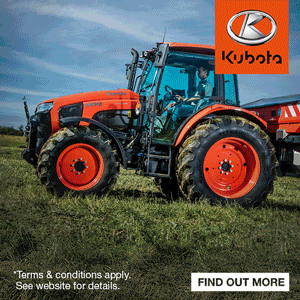After Jeremy’s excursion into the Lamborghini tractor market, there is one question that will have entered the minds of all farm-owning viewers. This question is inescapable, even for those who watched Jeremy get into immense difficulty whilst climbing a steep, muddy bank.
“Should I buy a Lamborghini tractor?”.
Vintage Lamborghini
The natural assumption for those with limited heritage tractor knowledge is that Lamborghini entered the tractor market on the back of its success selling luxury supercars. Few are aware that it is in fact the other way around.
In 1948, out of the ruins of World War Two, Ferruccio Lamborghini started manufacturing tractors in northern Italy. Named Lamborghini Trattori, the first Lamborghini tractors were produced using components from discarded military machines and haulage.
Initial success set the company on its course to become a global name, producing some excellent tractors along the way.
If you can find one, you might be interested in purchasing a Lamborghini 2R. These tractors are powered by three-cylinder diesel engines producing almost 40bhp with four-speed manual gearboxes. You are unlikely to be using these tractors for heavy jobs on your farm, but you will be the envy of the local community. Vehicles of this year tend to compare well against other vintage tractor prices; there are instances of sales around the £20,000 mark.
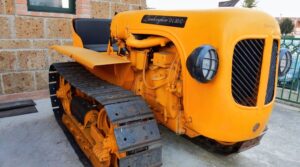
You might consider dipping further into Lamborghini’s rich history to uncover the DL 30 C. Producing 30bhp from a twin-cylinder engine, these 1957 tracked tractors were typically manufactured in Lamborghini’s trademark yellow. DL 30 C price points will vary considerably, dependent upon the condition of the vehicle.
The older the tractor, the further afield you might have to consider. A 1950s Lamborghini tractor is far more likely to be listed for sale on the European mainland than in the UK.
Top of the range
Of course, the vintage tractors of the 50s and 60s can hardly be compared to the bullish, powerful, high-tech cousins, produced today by Lamborghini Trattori owners Same Deutz-Fahr.
Jeremy’s world-famous R8 270 DCR certainly makes an impression; over 3m tall and weighing a healthy 10 tonnes. A six-cylinder engine is required, producing 275 bhp with a staggering maximum lifting capacity of 10.5 tonnes.
Lamborghini doesn’t just produce big and brash either. The current Lamborghini product brochure boasts a large fleet of both open field and compact tractors that reflect the needs of an average UK farm.
The Lamborghini Spark 135 R VRT is a much lighter vehicle, weighing 5.5 tonnes and powered by a 143bhp Deutz engine. This tractor is perfect for precise tasks, such as specialised crop management and provides superior comfort to its operator.
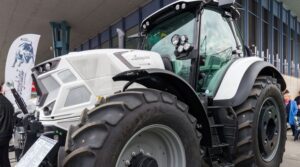
Is a Lamborghini tractor worth your time and money?
The UK market is sparse for this tractor brand at all price points. This is partly because of Lamborghini’s focus on sales on the European mainland.
This is despite the popularity of the brand in the UK. At the time of writing, not a single Lamborghini tractor is listed on FarmAds. With so many admirers of the brand, models that do appear are often sold right away.
There are a great many practical reasons why a Lamborghini tractor could make sense on your farm. You may use these to justify your decision, but you will also know deep-down the real reason why you bought one, too.
According to Case IH, the economic, efficiency and environmental benefits of enabling one operator to do more with one machine have influenced the development of its new largest tractor – the Quadtrac 715 AFS Connect. With a peak output of 778hp, it’s reckoned to now be the world’s most powerful production tractor, and sits atop a line of other revised 522–699hp Quadtrac AFS Connect and Steiger AFS Connect tractors, but has distinct styling and other features.
“The Quadtrac 715 development is about more than more power,” said Franz Josef Silber, Case IH product manager for high-hp tractors.
“It’s about ensuring implements are operated at their ideal speed for best performance and higher work rates, and allowing operations to be performed at the ideal time and with maximum output in short weather windows. We also wanted to boost soil protection via a bigger footprint and fewer passes, which also means greater efficiency and minimal trafficked land.”
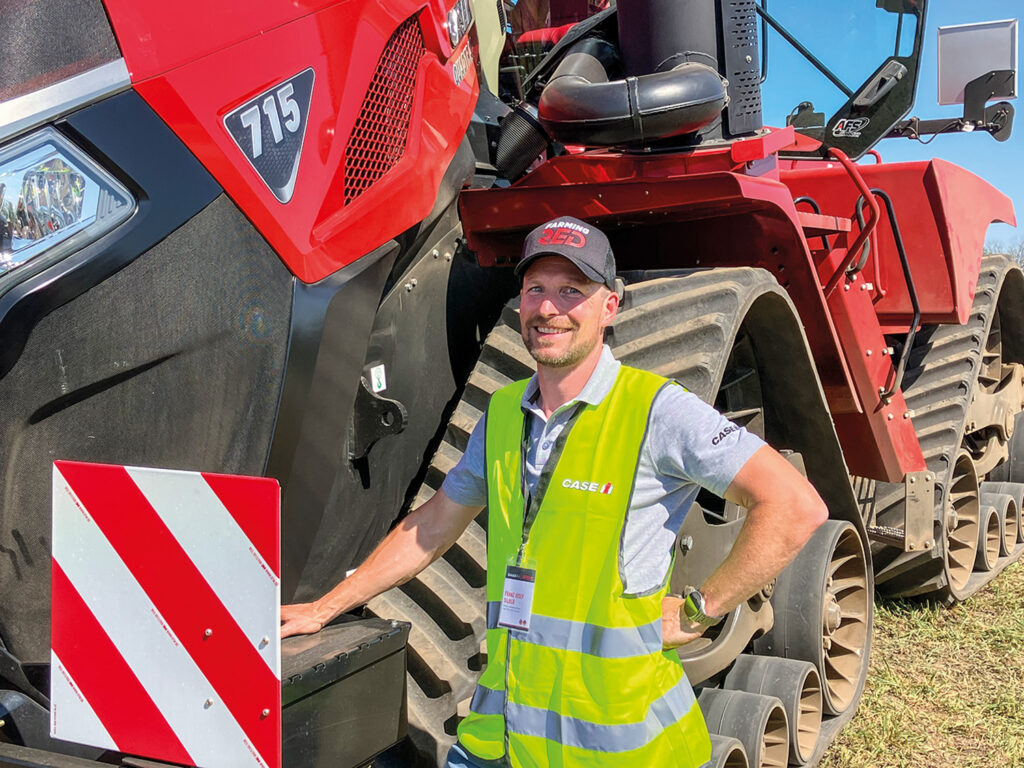
The Quadtrac 715’s uprated track units increase footprint by 6%, and the 1,008mm drive wheels help ensure engagement with five track lugs for enhanced power transfer, said Franz-Josef Silber.
The Quadtrac 715 features FPT’s Cursor 16L TST engine, making its debut in a tractor. Displacement is 23% greater than the next-model Quadtrac 645’s Cursor 13L TST, delivering 778 peak horsepower at 1,900rpm and 3,255Nm peak torque at just 1,400rpm. TST denotes the twin-stage intercooled turbocharging system, said to ensure fast response under load, while further features include an improved EGR-free combustion chamber, a 2,500Bar common-rail injection system and increased maximum cylinder pressure up to 220Bar, a package said to produce more power with greater efficiency and low fluid consumption. To match the higher output, the rear frame’s wider saddle tanks hold 1,968 litres of diesel.
The larger capacity twin turbochargers each have an air-to-water cooled intercooler, and Stage 5 emissions regulations are met via a simplified selective catalytic reduction (AdBlue-based) system.
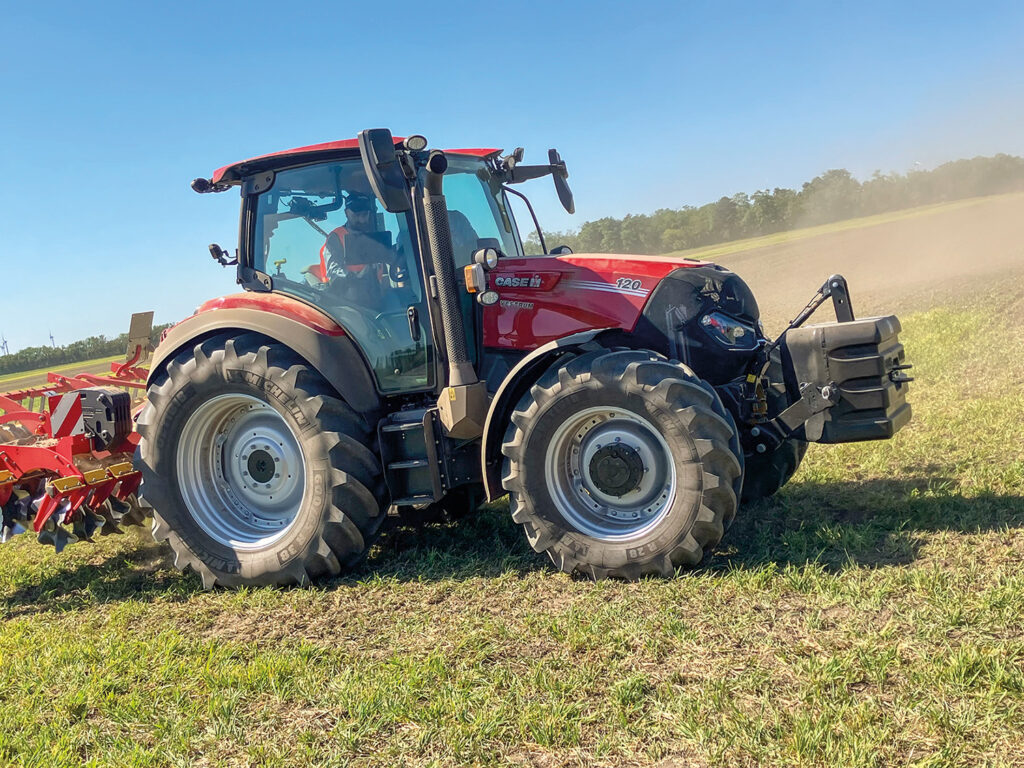
The ActiveDrive 8 eight-step/three-range powershift from 116–145hp Maxxum tractors is now an option for the 110–140hp Vestrum models, in lieu of the established CVX CVT.
Track units upgraded
The Quadtrac 715’s new heavy-duty track units are another major change over other models in the Quadtrac range. They provide 6% more footprint, while at 1,008mm the drive wheels are almost 100mm larger, and mean five track lugs are engaged with the drive wheel rather than four, to handle the higher torque and maximise track life.
The Quadtrac 715’s styling is a marked departure from that of its stablemates, with a distinctive new bonnet, which can be raised higher for enhanced service access, with electric raising/lowering via a switch near the cab steps.
A Category 5 drawbar matches the 715’s implement-handling capacity, while an optional category 4 three-point hitch lifts 9,897kg, and up to eight remote valves are supplied from either a 260-litres/min or optional 514-litres/min twin-flow SmartTorque hydraulic pump.
The new 715 sits atop four further new Quadtrac models and two wheeled Steiger options, all also featuring AFS Connect, which retain more familiar styling but also gain new features. They cover a 522–699hp range, from Stage 5 engine upgrades said to improve engine response time by up to 35%. Engines benefit from an updated fuel system with new fuel injection and a new fuel lift pump. Transmission options include PowerDrive powershift and, on models up to the 555, CVXDrive continuously variable transmission.
Cab updates include a roof-top design with new roof lights available, a premium sound option, RAM monitor mounts and additional console storage. A second AFS Pro 1200 display is optional to allow separate monitoring of Isobus implements.
Vestrum now with powershift option
For farmers looking for something with a little less horsepower, Case IH’s ActiveDrive 8 eight-step/three-range powershift, as established on its 116-145hp Maxxum tractors, is now also an option for its 110–140hp Vestrum models for customers not requiring the full capabilities of its CVXDrive CVT. The three ranges have speed bands of 0–10.7kph, 4.3–18.1kph and 0–40kph, while a skip-shift function allows quick powershift step progression. A creep speed option is available for specialist applications.
“Visitors to Agritechnica – or, in the near future, their local Case IH dealer – will also be able to see further Case IH updates and introductions,” said Ross Macdonald, utility tractor product manager at Case IH and Steyr parent CNH Industrial.
“They will include the new Optum 340 CVX tractor and some significant harvesting product developments, plus a revised seven-model Farmlift telehandler range with variable-flow 160-litres/min hydraulics, new smart hydraulic features, an electro-hydraulic self-levelling headstock and multiple cab comfort and operating upgrades.”
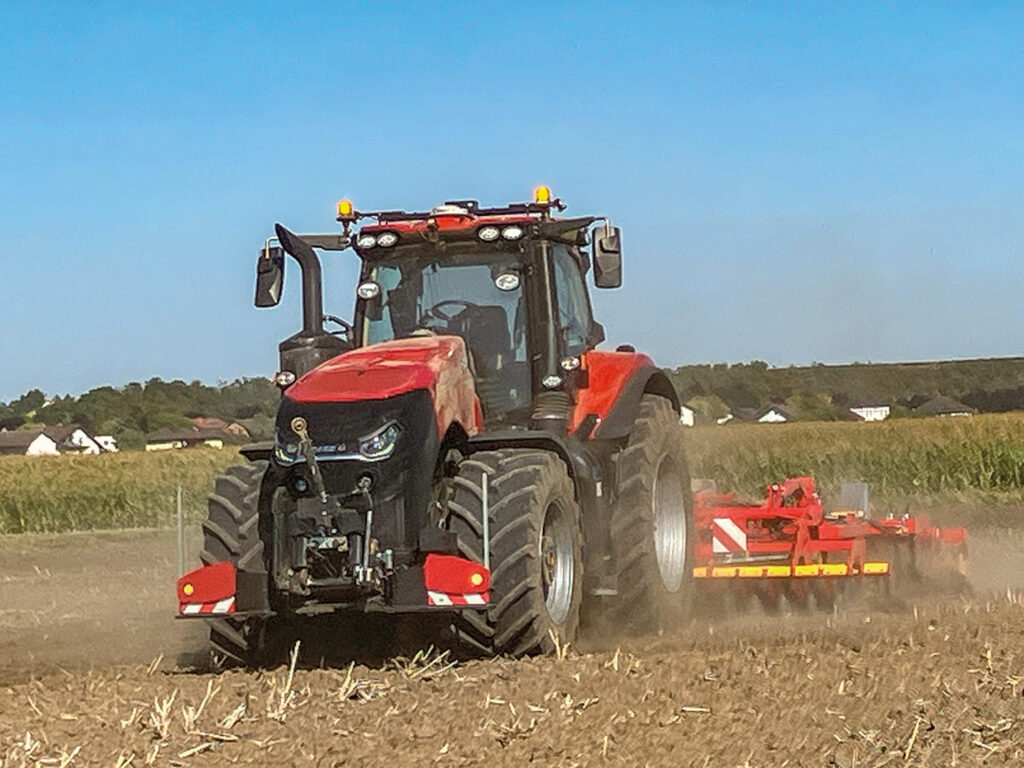
The Austrian field event featured one of the first public European demonstrations of the fully-autonomous development of the Case IH Magnum.
Autonomous tractor demoed in the field
A highlight of Case IH’s early autumn field event in Austria was the chance to see at work the fully-autonomous development of its Magnum tractor. Said to have been designed in response to farmer demand in certain regions for equipment to help meet labour challenges, allow skilled staff to be relieved of monotonous tasks and focus on those better suiting their skills, make the most of weather windows and enhance productivity via 24-hour working, this was the first time the machine had been shown publicly at work in Europe.
Beyond its ability to operate autonomously, the tractor has specifications that otherwise match its conventional cousins in areas from engine power to transmission type and implement handling capabilities. The latest development machine can be operated supervised – with an operator as an observer in the cab and able to manage the tractor’s autonomous and other systems – or unsupervised and driverless, being managed and monitored remotely.
“Our research suggests farmers believe such a system will be most beneficial where they can operate one machine in a field and have another working alongside it without an operator,” said Alessio Quatraro, EMEA product manager for autonomous driving at Case IH.
“When the cab is unoccupied, the tractor is started and stopped using the tablet interface via a wireless internet connection. The current incarnation of the tractor is able to operate autonomously at up to 24.1kph (15mph), with perception system development ongoing to allow for higher speeds. With an operator in the cab, it’s possible to operate at field speeds within the machine’s capabilities. Tougher soil areas or hills/hollows can be mapped when planning operations to ensure forward speed is adapted where necessary to account for adverse conditions.”
During operation, a combination of cameras and radar is used to constantly monitor the tractor’s surroundings for obstacles and motion initiation. Using artificial intelligence, a continuous stream of images is processed and interpreted and any obstacles identified. If one is detected, the tractor halts and the owner/manager’s linked smart device receives an alert, allowing the situation to be assessed and the next course of action determined. Should an obstacle detection sensor fail, there are integral fail-safe procedures to operate equipment in a safe mode until human intervention is possible. If a sensor should fail – very unlikely, says Case IH – the machine stops and sends an alert to the operator’s smart device.
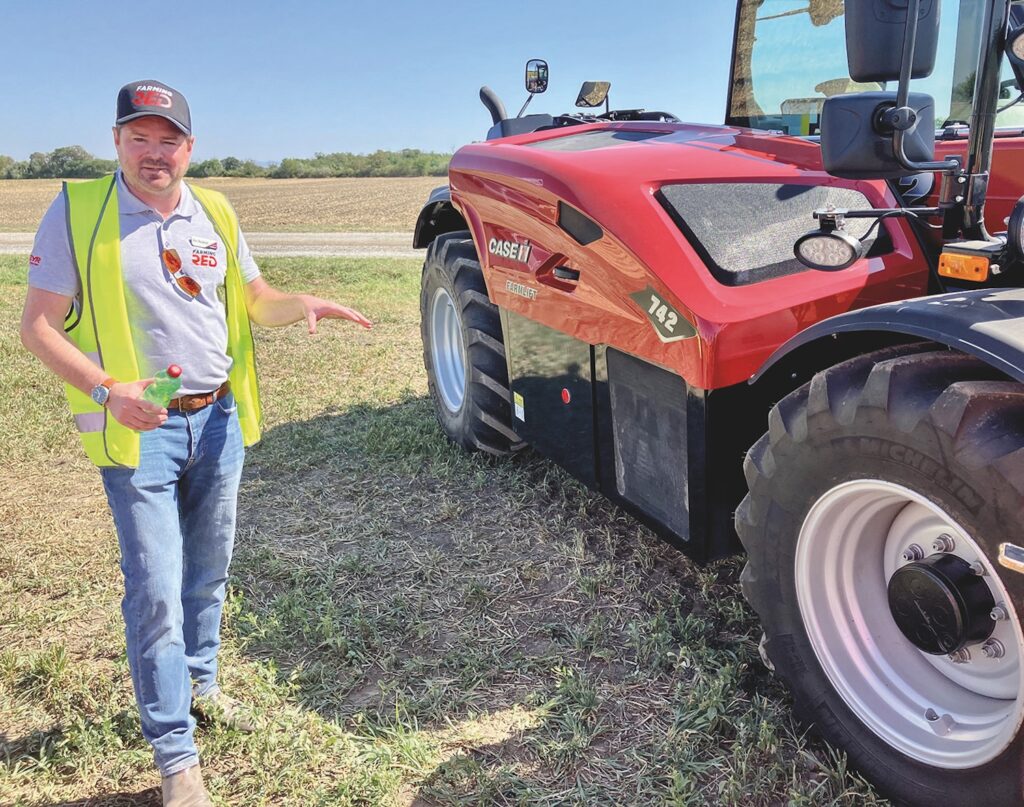
UK-based Ross Macdonald said there was more to come at Agritechnica from Case IH, including Farmlift telehandler updates.
“Low light levels and darkness do not affect operation of the tractor and its systems, with additional lights fitted to ensure full functionality of the perception technology is maintained in such conditions,” explained Alessio.
“Once work is completed in a particular field, the tractor can be driven by an operator to its next destination.
“We have displayed our intent in autonomous tractor development at various points over recent years, with the project continuing to advance as systems are thoroughly tested and validated.
“While we continue to adapt, develop and update as technology evolves and legislation changes, we are progressing the project with a long-term goal of commercialisation.”
The new 600-Vario series tractors are designed to compete for a large market share in one of the most popular and competitive market sectors, where tractors with power outputs from 150–200hp meet the needs of arable, livestock and mixed farms and many operate with front loaders.
Fendt’s new models fill the gap between the current 500 Vario and the 700 Vario Gen 6 series. The gap relates more to model numbering than power outputs, as there is already a crossover between the most powerful 516 Vario with up to 163hp, and the current entry 714 Vario with 144hp.
However, the new 700 Vario Gen 7 line-up, announced last year, starts at 203hp and Fendt has already confirmed that the 714 Vario and 716 Vario models will be discontinued in late 2024 – coinciding with early deliveries of the new 600 Vario.
600 Vario
There are four new 600 Vario models, starting with the 164hp 614 Vario. They all use Fendt’s Dynamic Performance design strategy which compensates for parasitic losses including powering lights, air conditioning, power steering and other tractor systems to ensure full power is available at any speed and for any application.
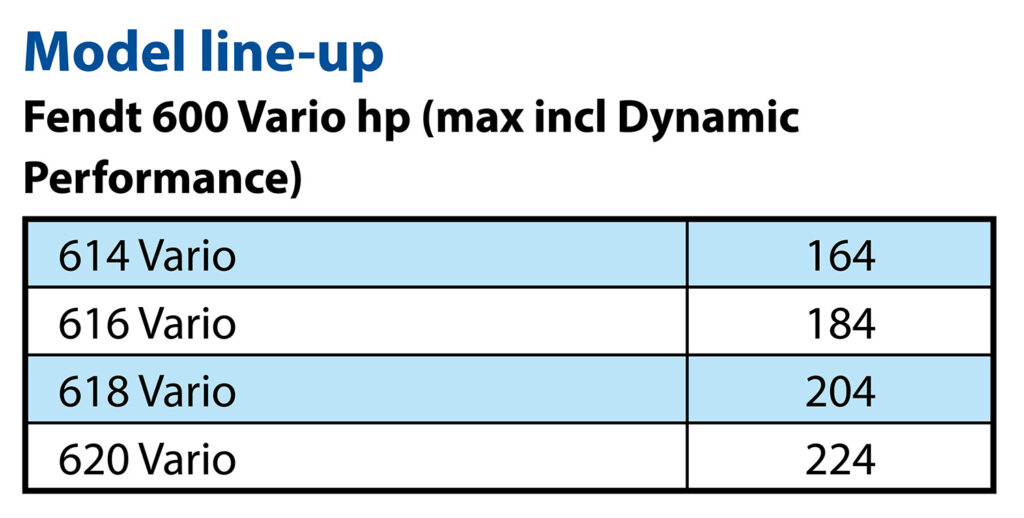
Power is from a brand-new AgcoPower 4-cyl, 5-litre engine. The Core 50 power unit is described by Fendt as ‘little brother’ to the 6-cylinder Core 75 fitted in the new 700 Vario Gen 7 tractors.
The Core 50 has hydraulic tappets to reduce maintenance requirements (services every 500 hours), an electronic wastegate turbocharger which contributes to the flat torque curve, and it is future-proofed with synthetic fuel compatibility.
The new engine has also been designed to operate on methane if models fuelled by the gas are offered in future.
FendtID low engine speed concept
Like larger Fendt models, the 600 Vario-series utilises the FendtID low engine speed concept to maximise efficiency and save fuel. Maximum power is at only 1,900rpm and the flagship 620 Vario develops its impressive maximum 950NM of torque across a wide rev range from 1,200–1,600rpm. The Fendt 620 Vario gains the mantle of the industry’s most powerful 4-cyl tractor, and compared to other makes and models the revs are extremely low.
Fendt UK marketing manager, Ed Dennett told Farmers Guide that the power and torque characteristics of the new 600 Vario-series are like those of competitors’ much larger 6-cylinder engine models.
Exhaust emission regulations are met using SCR (AdBlue) only, with DPF and a DOC, and there is no EGR. The design maximises efficiency and avoids high operating temperatures. AdBlue consumption is quoted as 6.5% relative to the volume of diesel.
The cooling pack is compact and neat to maximise forward visibility, and a conventional belt-driven fan layout is used rather than the concentric hydraulic-drive design of latest larger models. Viscous drive matches the cooling power to the requirement.
For the most demanding applications, a hydraulic blade pitch adjustment option can be specified. This also allows the air flow to be temporarily reversed to blow loose debris and dust from the air intake grill and cooling system. Its operation can be managed through the FendtONE terminal so that it activates automatically at timed intervals or at each headland turn, for example.
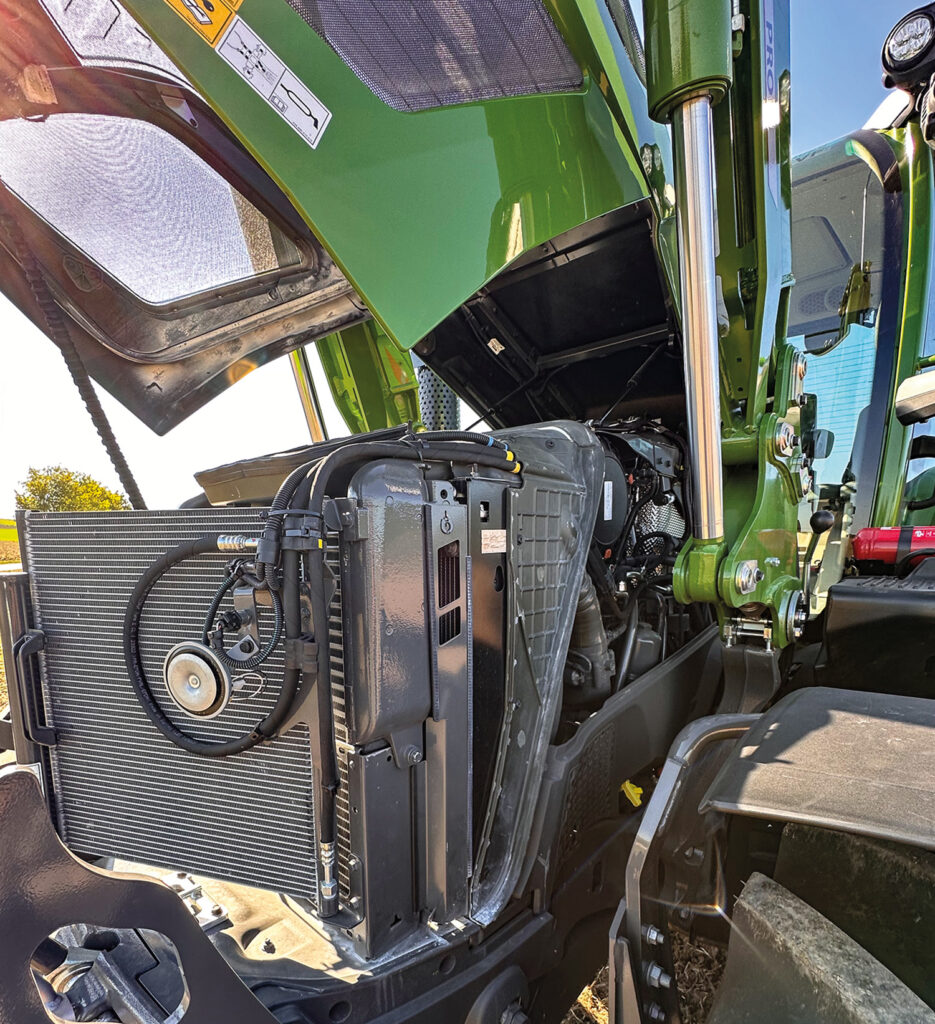
224hp from a brand-new 5.0-litre, 4-cyl engine. Conventional cooling is used.
With VarioDrive
Like the larger models, the 600 Vario features VarioDrive transmission and a new TA150 version of the gearbox has been developed for the smaller tractors. Using one pump supplying oil to two separate drive motors, it automatically adjusts power distribution between the front and rear axles, and 4wd is automatically engaged whenever it provides an advantage.
A single operating speed range from 0–50kph means there is no need for users to select field or transport working modes, and at higher road speeds the drive to the front wheels completely disconnects to avoid losses through the system.
A benefit of delivering drive independently to the front and rear axles is that, during tight turns, the front wheels can be accelerated to pull the tractor around in the steering direction. The result is an incredibly tight turning radius
of only 10.2m on 540/65R30 front tyres.
The system also avoids front wheel lead issues as the speed of each axle is matched, whether turning or travelling in a straight line. Tyre wear is reduced and less power and fuel are wasted, especially during loader operations on hard surfaces.
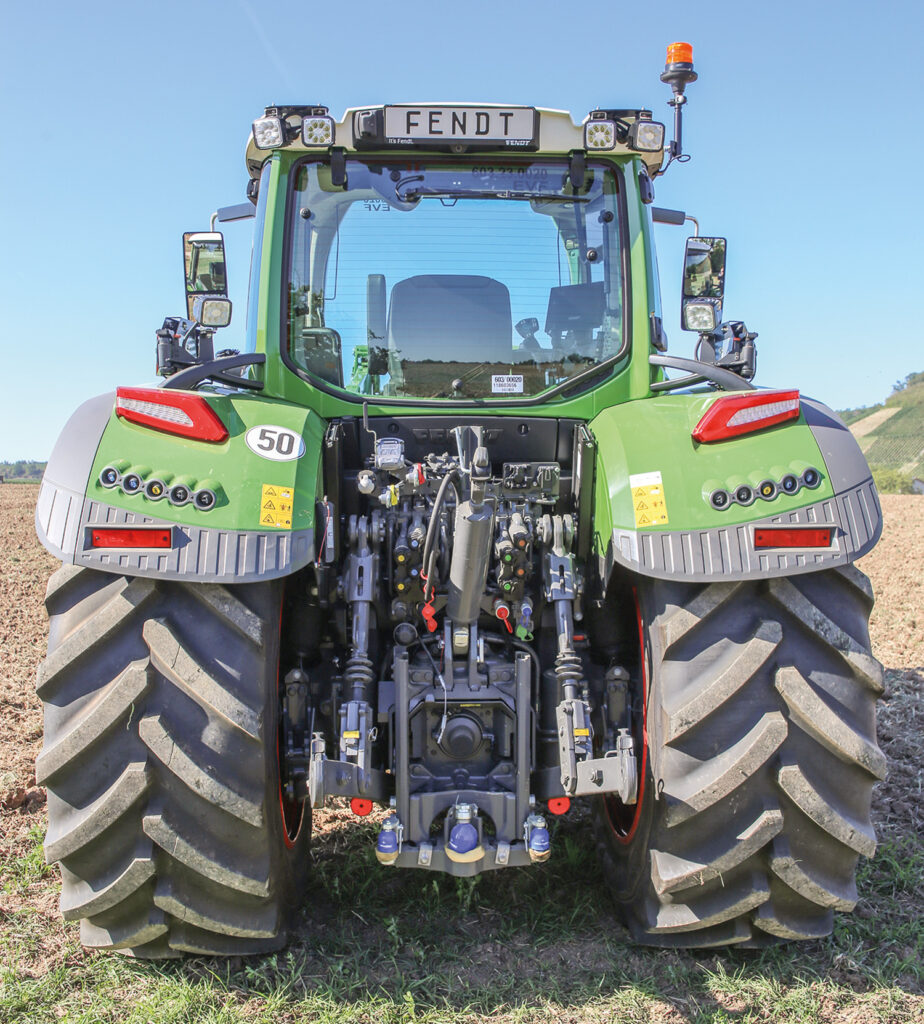
The 600 Vario models can be ballasted to 13.5t. Standard wheel and tyre equipment includes 650/65R42 tyres at the rear and 540/65R30 at the front. Maximum hydraulic flow of 205 litres is available as well as power beyond.
Lightweight and versatile
The 600 Vario models all share a 2.72m wheelbase – 6cm shorter than the 700 Vario Gen 6, and the same as the older 820 Vario. With a front linkage and PTO, the 600 Vario models weigh 7.7t unladen, but have an impressive 13.5t gross vehicle weight allowing them to be heavily ballasted for maximum traction to make the most of the impressive pulling capability, or to carry large implements including high-capacity spreaders and sprayers.
Standard tyres are 650/65R42 at the rear and 540/65R30 at the front. Fendt VarioGrip central tyre inflation is an option, capable of inflating the tyres by 1Bar in under five minutes. Ed commented that it wasn’t previously an option for mid-sized models, but that 80% of 800 Vario and 900 Vario tractors sold in recent years have been specified with the system.
Impressive hydraulics
The new models boast impressive hydraulic capability. The standard pump supplies 152 litres/min, but an optional upgrade to 205 litres/min is available. A maximum of five hydraulic spools can be specified at the rear and power-beyond is an option.
Like the new 700 Vario Gen7 models, the new 600 Vario can be equipped with a dedicated valve block with three oil supply outlets for the front loader, leaving other valves available for implements. Two additional spools can be fitted at the front. Capability to tip large trailers and work with complex implements is ensured with up to 65 litres of oil available for use off-board.
New front loaders
New front loaders have been added to the range for the 600 Vario tractors. The most powerful Fendt Cargo 5.90 loader lifts up to 3.46t and has a maximum lift height of 4.5m. It is available with a weighing function.
An optional 3L joystick can be added to operate the loader, enabling three hydraulic functions to be performed simultaneously – and making it especially suitable for silage grabs. It also includes shift buttons for forward and reverse, allowing loader and driving control using only one hand while the other operates the steering wheel.
Fendt also demonstrated a new optional steering joystick at the event. This mounts on an armrest on the left side of the driver’s seat and allows proportional and effortless steering from lock to lock by moving the handle from side to side.
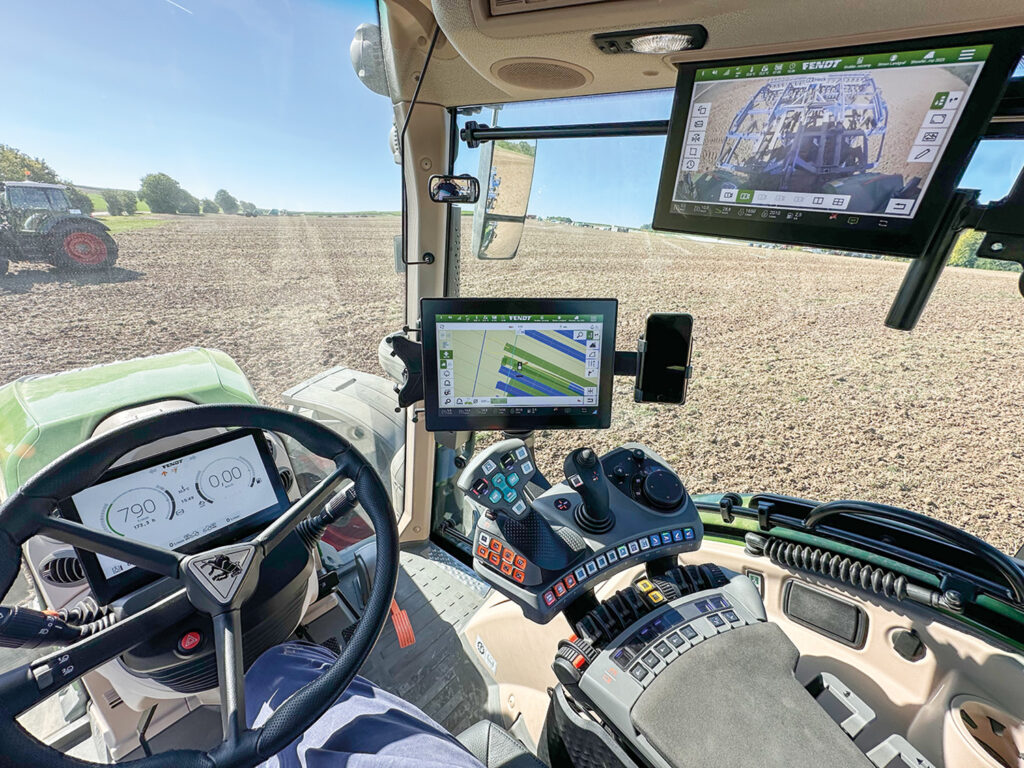
FendtONE allows up to three terminals to be used simultaneously.
FendtONE cab
Fendt has equipped the 600 Vario series with the FendtONE operating concept. This was introduced on 700 Vario Gen6 tractors approximately four years ago and gives operators great flexibility in tailoring the controls and displays to suit personal preferences and the task. A multifunction joystick, 10in digital dashboard and a 12in touch terminal on the armrest are standard and an additional 12in drop-down touch terminal can be added in the cab roof on the right-hand side.
Almost any operating information including tractor settings and performance data, GPS field maps and Isobus-implement displays can be allocated to any of the screens, and there is also the option to show the same information on multiple screens or divide the screens into sections each displaying different images or data.
There is full compatibility with Fendt precision farming systems including Fendt Guide guidance, Fendt Section Control and Fendt Variable Rate Control, and Fendt Connect telematics are standard.
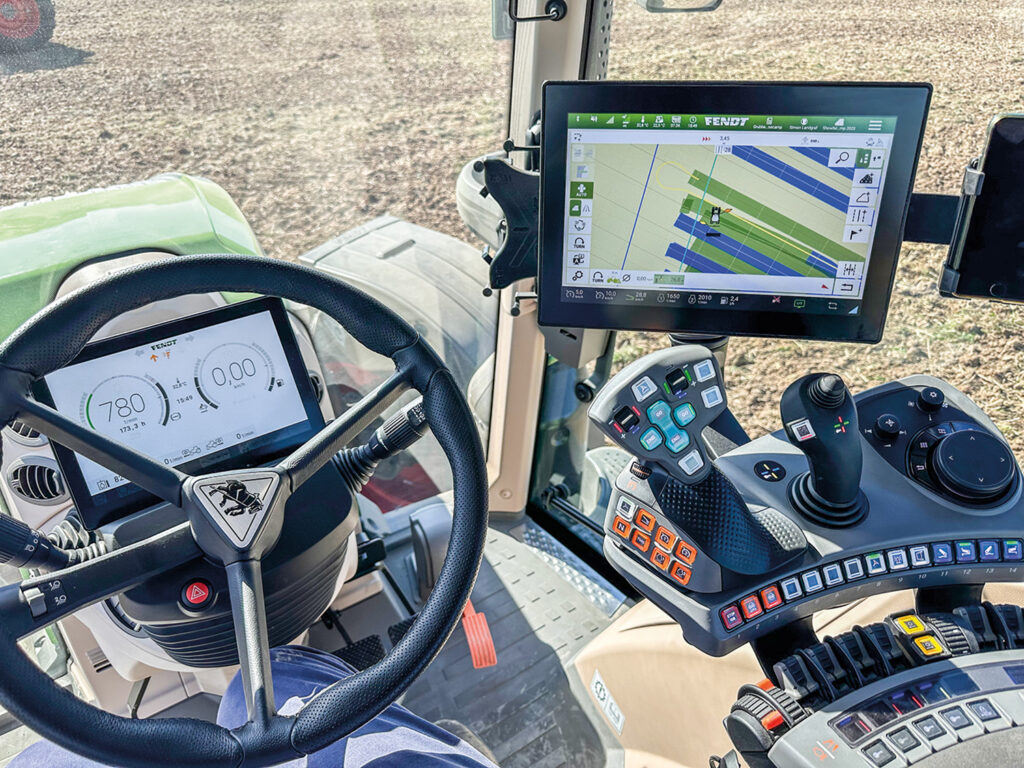
The FendtONE armrest provides plenty of opportunities for operators to set-up the controls to suit the task and their preferences.
Generous specification
The VisioPlus cab has Cat 2 air filtration as standard, and Cat 4 air filtration is an option. Like larger 700 Vario models, the new 600 Vario has a panoramic curved windscreen providing a clear view of the front loader at maximum height. The low, narrow bonnet allows a superb view to the front, including down to the wheels, and the standard front wiper has a 300-degree sweep area. An optional right-side window wiper sweeps 97 degrees for a clear view to the side.
The air conditioning system is significantly uprated and quoted cab noise levels of just 68db contribute to operator comfort. There is a choice of seats, including the top specification with integral heating and cooling, four-way lumbar support, adjustable side bolsters, massage functions and a memory – allowing saved user profiles to be stored and retrieved by selecting them on the touch-terminal.
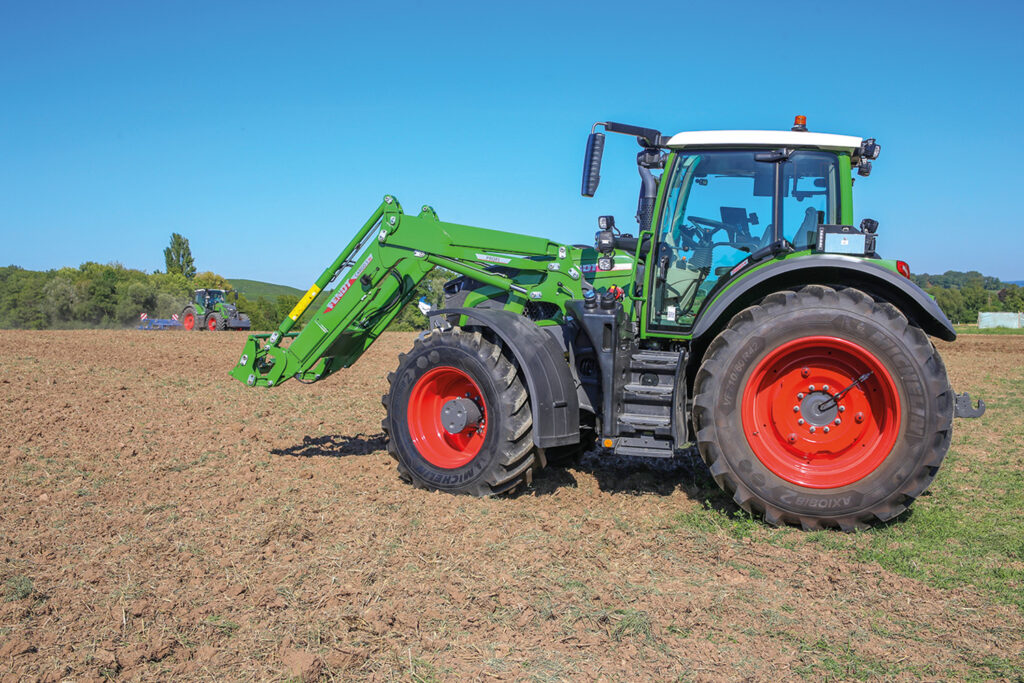
Many 600 Vario tractors will be bought for loader work. A new Cargo 5.90 front loader has been designed specially, with 3.46t lift capacity and 4.5m maximum lift height. Load weighing is an option.
Test drive
The two tractors at the press event were the only two 600 Vario tractors manufactured so far in the finished guise, and one of these was due to be cleaned up after the test-drive and prepared for exhibiting on the stand at Agritechnica.
Both tractors were the most powerful 620 Vario model. One was equipped with the new Cargo 5.90 front loader, and the other was attached to a 4m cultivator.
The FendtONE cab is comfortable and well laid out. The top-specification seat with pneumatic suspension was fitted.
The 4m Kockerling Trio cultivator working stiff, dry ground allowed the tractor’s power and traction capabilities to be thoroughly tested. Using the hydraulic top-link, the implement working angle was easily adjusted to vary the working depth of the front row of tines.
A working speed of 9.7kph was set on the cruise control, and as the tines were forced progressively deeper, the engine note altered as the torque increased, but the 224hp 4-cyl tractor coped impressively and maintained the set speed without fuss.
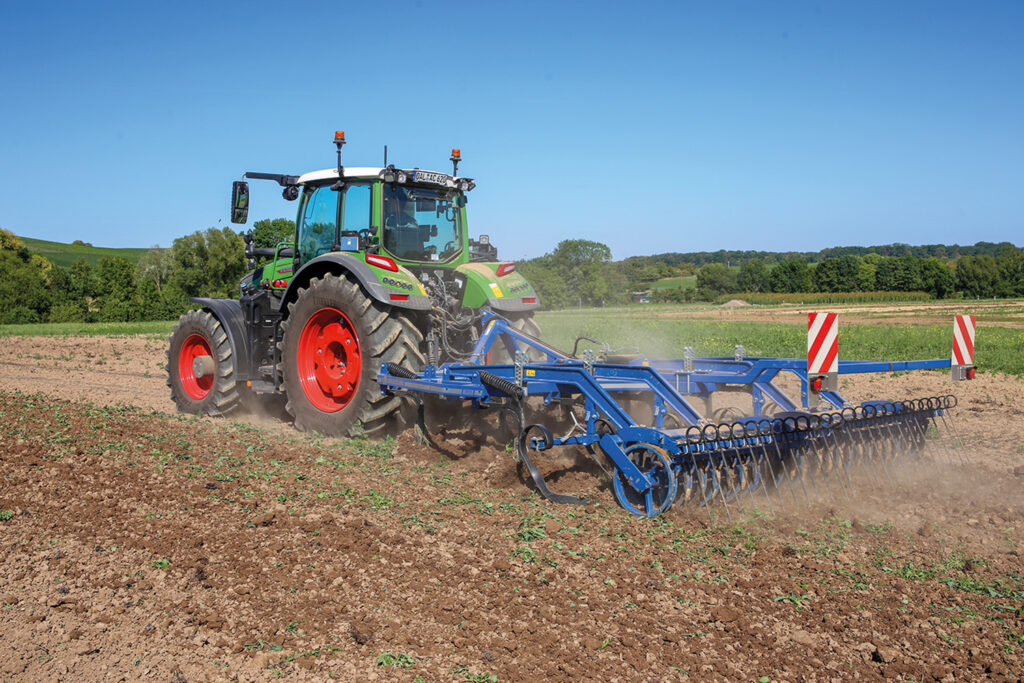
The Kockerling 4m cultivator working hard, dry ground took a lot of pulling, but the 600 Vario had plenty of power and traction.
The FendtID low speed concept works well, and after each headland turn the engine speed rose as the working load increased, and then dropped back as the FendtID management system tuned the engine and transmission for maximum efficiency.
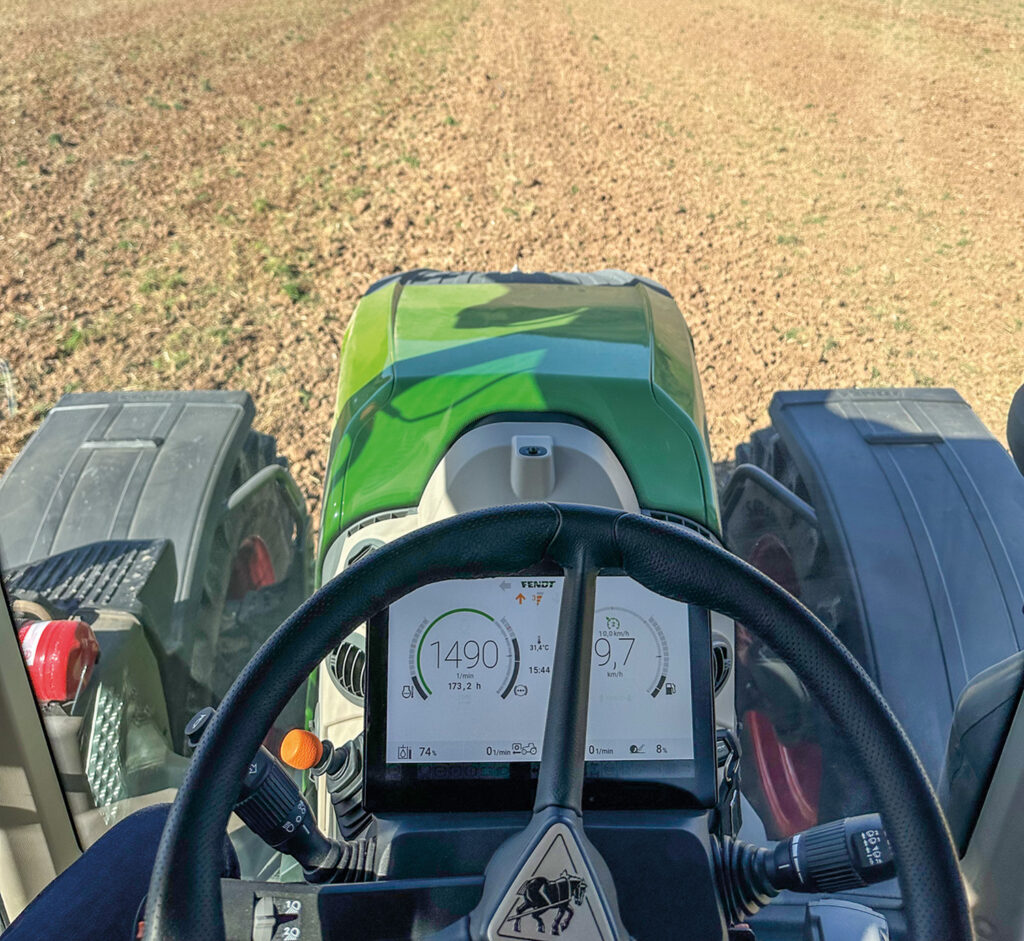
Visibility to the front is excellent through the panoramic curved screen. The dashboard display can show essential performance information, field maps, camera views or Isobus-connected implements.
At 9.7kph and with the tines pushed deep in the ground, the engine speed varied between 1,390–1,720rpm, and fuel consumption was approximately 37 litres/hour.
Headland turns were completed automatically, including steering to maximise working efficiency. An acoustic warning sounds as the headland boundary is approached and the intended turning direction is displayed on the screen. If this is acceptable, then the operator has nothing to do apart from monitor progress as the implement lifts and lowers automatically and pre-set speeds for working and turning are activated at the relevant times.
Even though the tractor was a pre-production, hand-built example, there were no vibrations or rattles and everything worked well. Monitoring noise levels during operation, the average was 68db, but with the climate control system turned off this reduced to 65–66db – very low for a hard-working 4-cyl tractor.
Testing the tractor at higher speeds up to 40kph on a concrete farm track, the front axle, cab and seat suspension performed well, and the tractor felt stable and secure.
Verdict
The new Fendt 600 Vario enters full production in July 2024, although orders will be taken following the Agritechnica launch.
Premium Fendt features such as VarioDrive are a big attraction, maximising performance, efficiency and productivity while also saving tyre wear and fuel. In terms of comfort, the cab is hard to beat and the FendtONE operating concept makes it a rewarding tractor to drive. Skilled operators have plenty of opportunity to tweak settings to get the most from the machine while those with less experience can utilise the user-friendly technology to help them operate effectively.
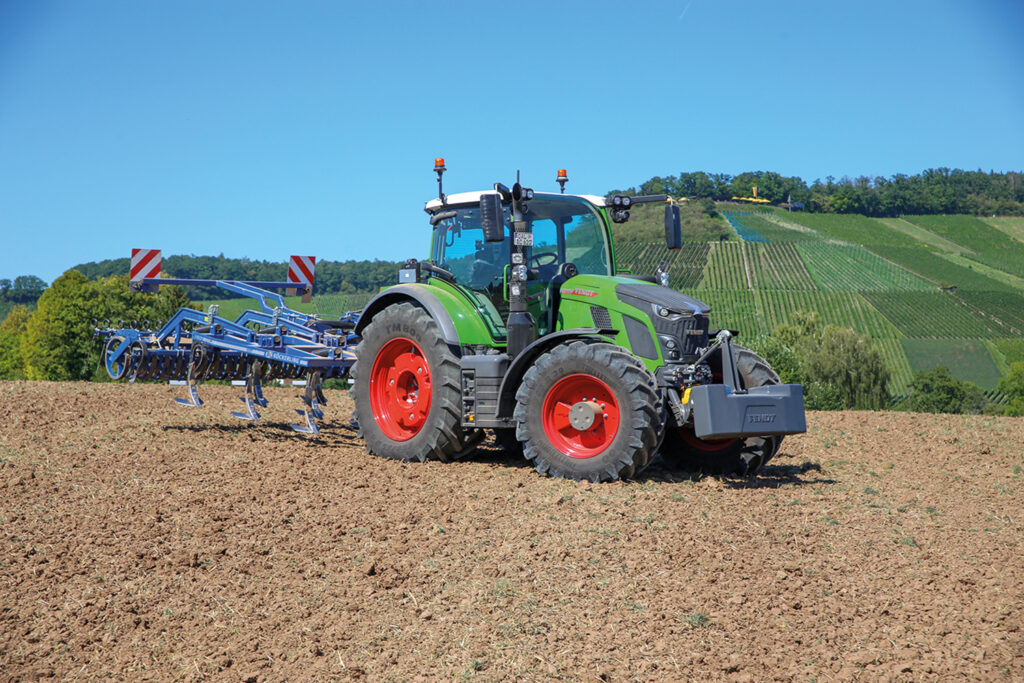
Many potential buyers will regard a 4-cyl engine producing 224hp with suspicion. However, after putting it through its paces and seeing how well it coped with the heavy draft load, it is hard to see how a 6-cyl tractor of similar power could offer advantages. The 4-cyl engine is smooth, quiet and economical and perfectly matched with the latest TA150 transmission.
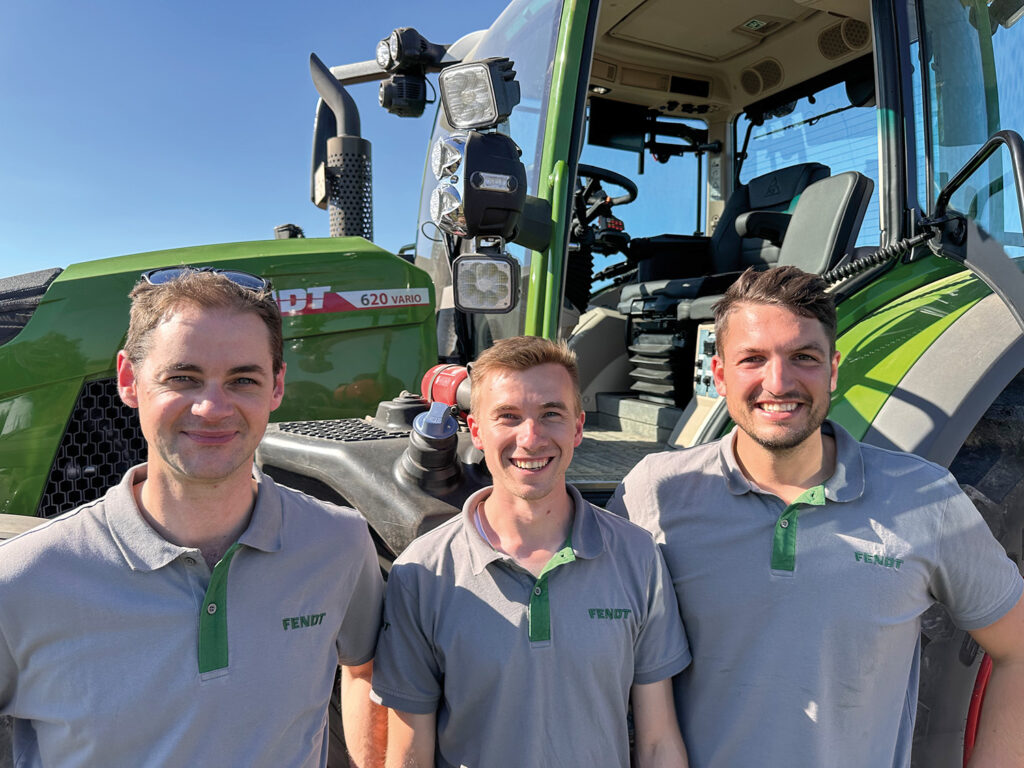
Pictured with the new 620 Vario are (l-r) Ed Dennett, Oskar Dreyer and Simon Landgraf.
Farmers Guide also tested the optional steering joystick available for the 600 Vario series, fitted to one of Fendt’s larger tractors. Loading soil from a heap into a trailer, it saved time and effort compared to using the steering wheel and it is likely to prove particularly popular with those buying the tractors primarily for loader work.
‘Large Square Baler Mode’ is a new software upgrade available for latest T7 LWB and T7 HD tractors with Horizon Ultra cabs and PLM Intelligence controls. Mode activation is through the Intelliview 12 touchscreen terminal, on the tractor settings display page.
The mode is compatible with all New Holland BigBalers produced since 2018 carrying the latest software updates.
How does ‘Large Square Baler Mode’ work?
When a New Holland BigBaler is linked through Isobus to the PLM-equipped New Holland tractor, the large baler mode software monitors the baling action to predict when each plunger stroke will occur. Additional fuel is injected to meet the momentary demand for extra power, just as the ram strikes the bale. This reduces engine speed variation and means that the PTO and baler transmission speed also remain more consistent.
The Terraglide hydraulic front axle suspension is also utilised by the system, and the cushioning action is stiffened momentarily to further reduce the nodding effect in time with each plunger compression stroke.
Is it effective?
Because Large Square Baler Mode is activated and deactivated by just a touch on the terminal, it is possible to compare operation with and without it on the move, while all other working parameters remain the same. Farmers Guide tried one of the latest T7 HD tractors with a New Holland BigBaler 1290HD, baling weathered barley straw on a large farm in Essex.
With Large Square Baler Mode engaged, the tractor stationary and the baler running at its standard 1,500rpm there was very little nodding movement, but as soon as the mode was switched off, the rocking motion increased.
Baling the swath, the same comparison produced similar results – when the mode was activated, the nodding motion reduced and the ride became more comfortable.
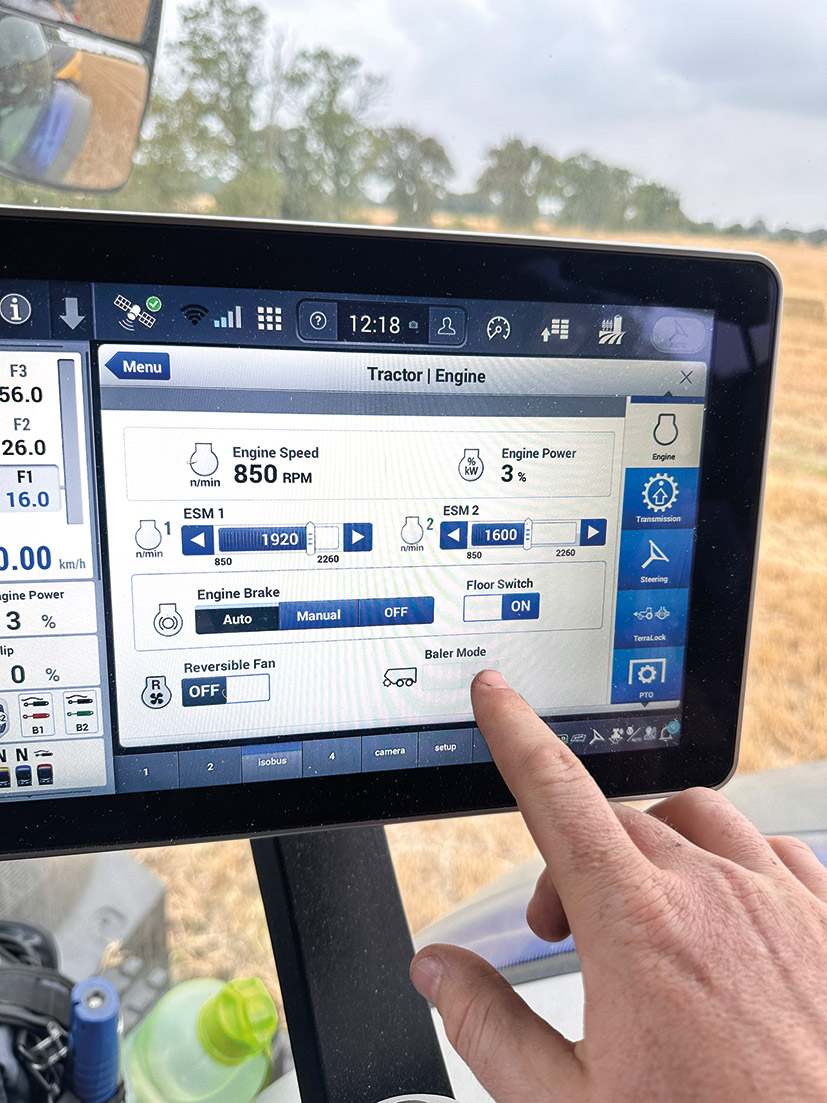
Large Square Baler Mode is activated through the Intelliview 12 touchscreen.
Operating characteristics
Interestingly, it takes a few seconds for the engine management system to ‘learn’ the plunger timing each time the mode is engaged, so the effect is gradual at first with full synchronisation after 10–15 seconds.
Apart from the reduced rocking motion, a change to the exhaust note is another indicator that large baler mode is selected. This is because the engine droop characteristics are adjusted, and revs are kept within tighter parameters. To achieve this; extra fuel is injected at precisely the right moment; a fraction of a second before the working load peaks as the plunger meets the bale – matching the power produced to the demand and reducing engine speed fluctuations.
Without baler mode, the engine management system works retrospectively to restore the engine speed to its pre-set value after it has been pulled down by the extra load, then extra fuel is injected to restore the revs.
We monitored noise levels inside the cab while switching between baler mode engaged and disengaged. The difference in exhaust tone is easy to detect, and the sound meter indicated noise levels approximately 1dB less with baler mode activated, although the working speed and straw volume remained constant.
New Holland claims that significant fuel savings are achieved by activating baler mode – as the tractor and baler operating speed remains more constant.
Experienced user view
The T7 HD tractor tested by Farmers Guide was a demonstrator on loan to Essex-based, Blackwater Baling. Owned and managed by Gavin Strathern and his wife Liz, Blackwater Baling operates as a grass and straw baling contractor and bale supplier. The contracting service cuts, prepares and bales hay, haylage and straw for customers from private horse owners to larger professional breeding and racing stables.
Straw baling is offered as a contracting service although a large amount is also bought in the swath and baled behind the combine, then transported and stored for supply throughout the year to farms in the East of England plus a growing number in the South-West. He also supplies bales as biomass for straw burning power stations.
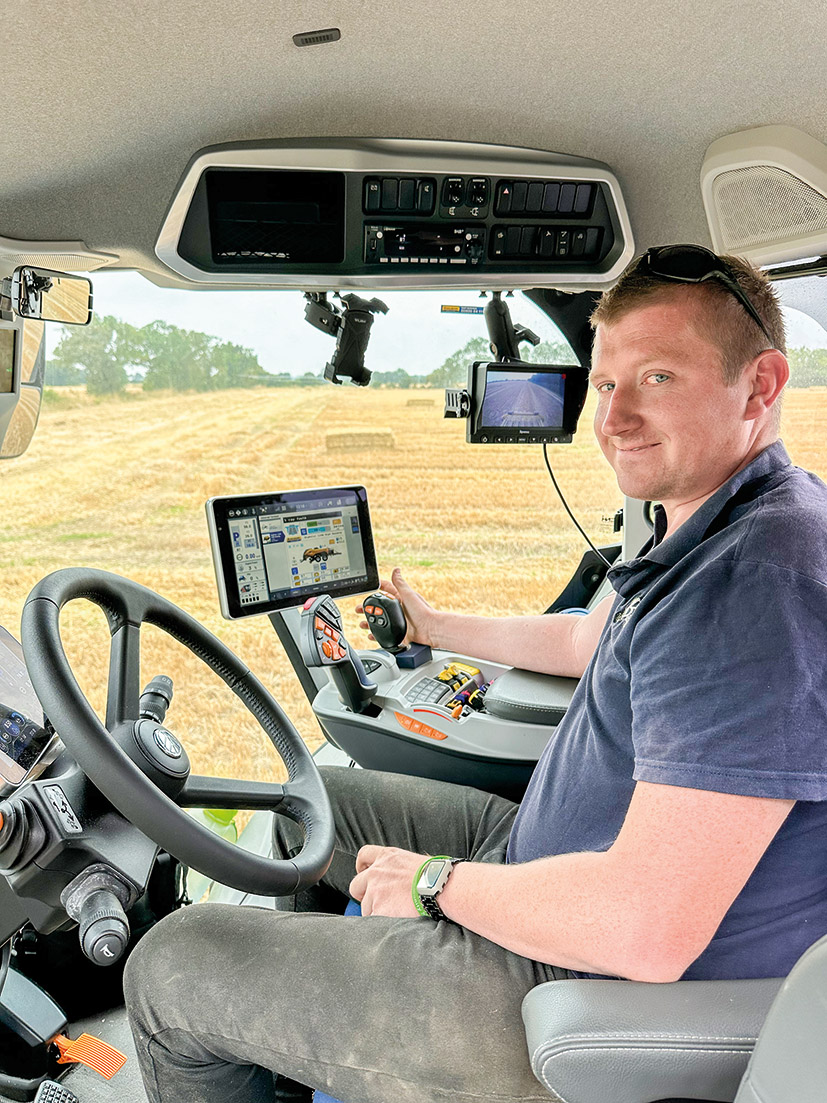
Experienced operator, John Baker said the mode makes a big difference to ride comfort. He also believes that it increases productivity and reduces operator fatigue, while also allowing him to drink cups of tea on the move without risking spillages caused by the baler’s characteristic rocking motion.
New Holland fleet
The company’s fleet includes eight New Holland large balers. An RB180 makes round silage hay, haylage and straw bales mainly for livestock use. Seven large square balers include BB920, BB1270, BB1290 BB9090 models, plus two recently acquired 1290HD machines selected to produce extra dense bales for biomass. The balers and Transtacker bale chasers operate behind a fleet of tractors, most of which are New Holland T7 machines.
“New Holland machinery supplied by our local dealer, Ernest Doe, makes up the core of our tractor and baler fleet,” explained Gavin. “There is no single reason for that – it’s because of the whole package including the machines and the way they are backed-up by the dealer and the manufacturer. The New Holland T7 tractors are bombproof, and we find them far more reliable than competitor brands. We own models from the T7.210 to the T7.270 currently, and hire two additional tractors through the grass and straw harvesting season.”
Up to 14 machinery operators are employed during the harvesting season which starts with first-cut haylage and concludes in the autumn when the last of the straw has been baled.
“We decided early on to specialise in baling and bale supply,” continued Gavin. “By specialising we can offer the most efficient service without being distracted by other tasks. We also offer grassland fertilising and spraying as well as pasture reseeding, which complements our grass harvesting service and is for the same customers.”
Added comfort, convenience and safety
Operator John Baker has extensive experience operating New Holland T7 tractors and balers, having worked for Blackwater Baling for the past five years. He spent a week driving the demonstration T7 HD tractor as well as a new T7.300 LWB model, both with Big Baler Mode, working with the company’s newest 1290HD large square baler. “It significantly improves comfort,” he said, “and it’s much easier to drink or eat while baling without risking spillages caused by the baler’s rocking motion. Using the touch screens and a smartphone is easier too. The effect is even more pronounced for a passenger, without the pneumatic suspension that benefits the driver.”
John said that the benefit of baler mode is especially noticeable when simultaneously baling downhill and turning. “Often, on steeper slopes it can feel as if a baler is pushing the back end of the tractor into a jack-knife with each plunger stroke, especially during tight turns. With the baler mode selected, that pushing action is reduced. The whole operation feels much more comfortable and controlled.”
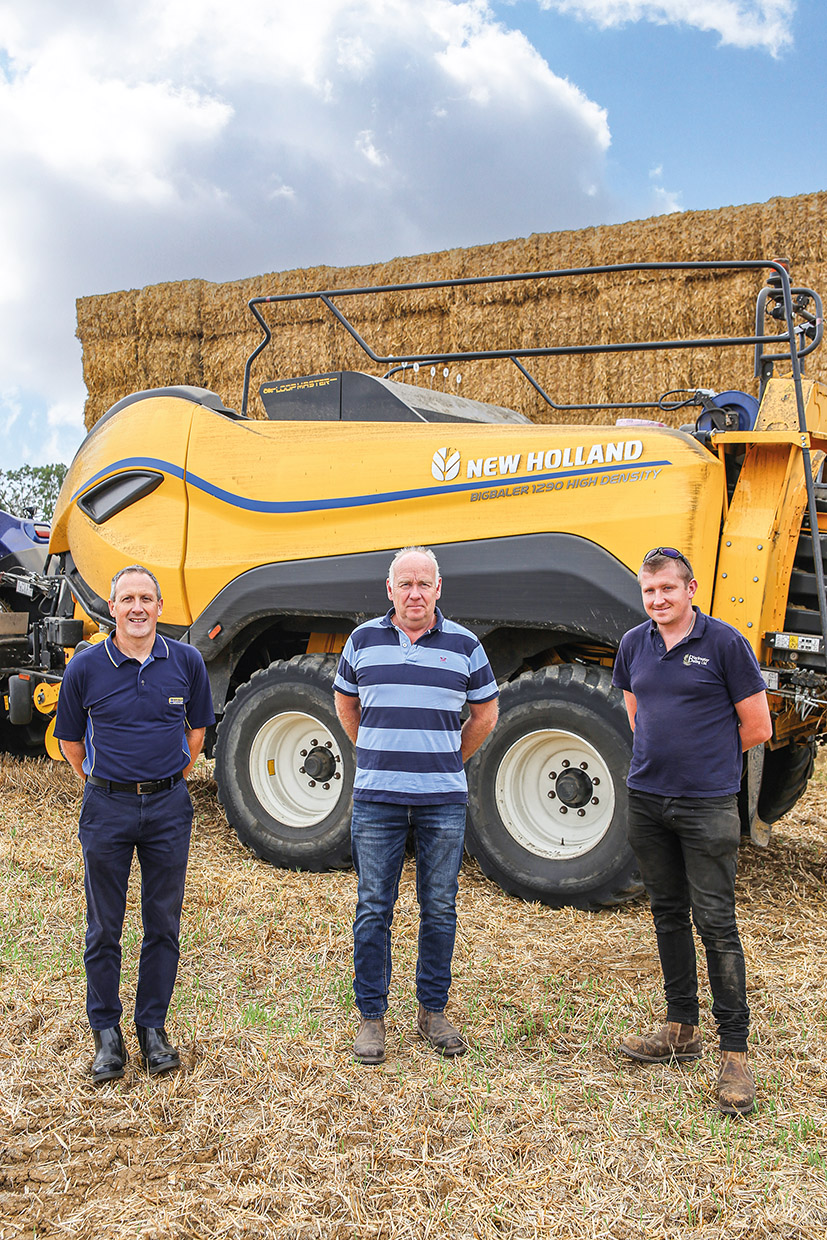
New Holland tractor product manager David Redman (left) is pictured beside Blackwater Baling managing director Gavin Strathern and baler operator John Baker.
Extra capabilities
Gavin said that all the operators who tried the two tractors with the baler mode were impressed. “We have a superb team of full- and regular part-time operators who work long days during harvest, and we rely on them to provide a great service for our customers. Their feedback regarding the latest T7.300 and the T7 HD tractor with the new cabs, and the enhanced comfort due to the Large Square Baler Mode software is extremely positive, and I am quite sure that when we next update the tractors, then it will be for models with extra power and the baler mode software unlocked.”
The verdict
Large Square Baler Mode is surprisingly effective. The constant ‘nodding’ movement associated with operating all large square balers is something operators accept as part of the job. However, by selecting a New Holland T7 HD or T7 LWB tractor with PLM controls to work with a compatible New Holland large square baler, this rocking action can be reduced improving operator comfort and reducing fatigue, with no reduction in baling rate or performance.
“I believe that because it manages engine performance so tightly to suit the baler, it actually increases the work rate while also reducing fuel consumption,” concluded John. “It’s worth having and I will request it next time my current T7.270 is due for updating.
“Just being able to drink cups of tea without having to stop on a headland or fight the rocking motion makes such a difference to a long working day.”
Mzuri’s new Pro-Til iGen one-pass drill
Farmers Guide attended an exclusive preview and demonstration of Mzuri’s new Pro-Til iGen one-pass drill on the manufacturer’s farm ahead of the new model’s official Cereals debut. David Williams saw it in action
The new drill fills a gap in Mzuri’s drill line-up, satisfying demand for a cost-effective, high-output direct drill with a 4.8m working width. “It’s a new approach for Mzuri,” managing director Martin Lole told Farmers Guide. “Like our other drills, it’s designed to produce a perfect seeding environment working straight into stubbles, cover crops and grassland. It is our only linkage-mounted model, but retains our proven seeding technique, producing a tilth, reconstructing the seeding zone and then placing and covering the seed. We firmly believe that this is the right approach to give crops the best start.”
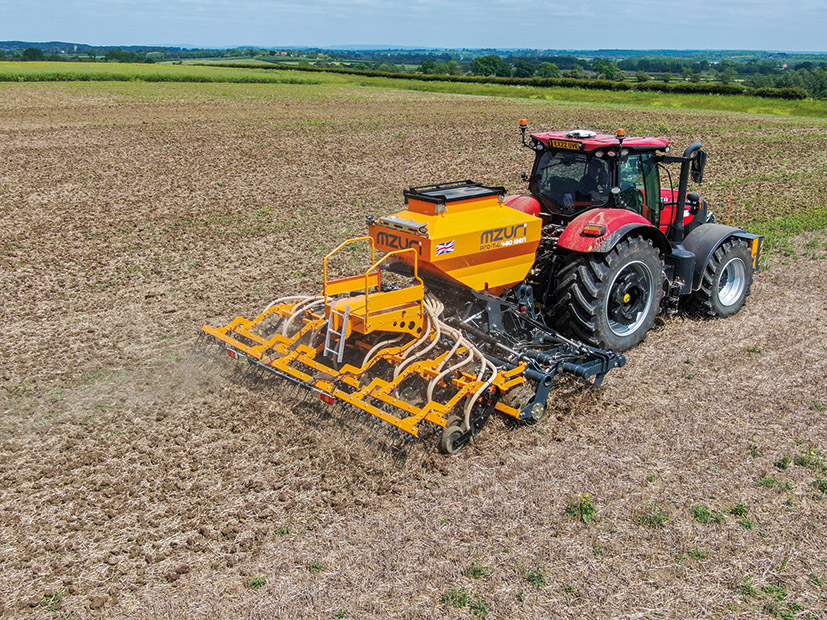
Farmers Guide saw the new Mzuri Pro-Til iGen 4.8m mounted drill at work in Worcestershire.
Wider appeal
Mzuri’s existing Pro-Til and iPass drills are all trailed, but Martin said that although drawbar drills do a better job of maintaining a constant drilling depth over undulating ground and reduce compaction on headlands, they cost considerably more than linkage-mounted drills which means that the price is often too high for smaller farms to justify. As well as a lower purchase price, advantages of mounted models include easier manoeuvring on headlands and around obstructions and more convenient travel on narrow roads, but disadvantages include reduced seed and fertiliser capacity due to weight limitations.
Increased demand
“We didn’t offer a 4.8m mounted drill previously, but requests from customers for a drill of that type and size were increasing as smaller arable and mixed farms want to reduce their crop establishment costs by reducing the amount of tillage,” stressed Martin.
“The 4.8m width is a good compromise. It’s easy to pull but can achieve high work rates, and only five bouts are needed for the headlands. However, we will almost certainly add 3.0, 4.0 and 6m versions in future to benefit more sizes and types of farms.”
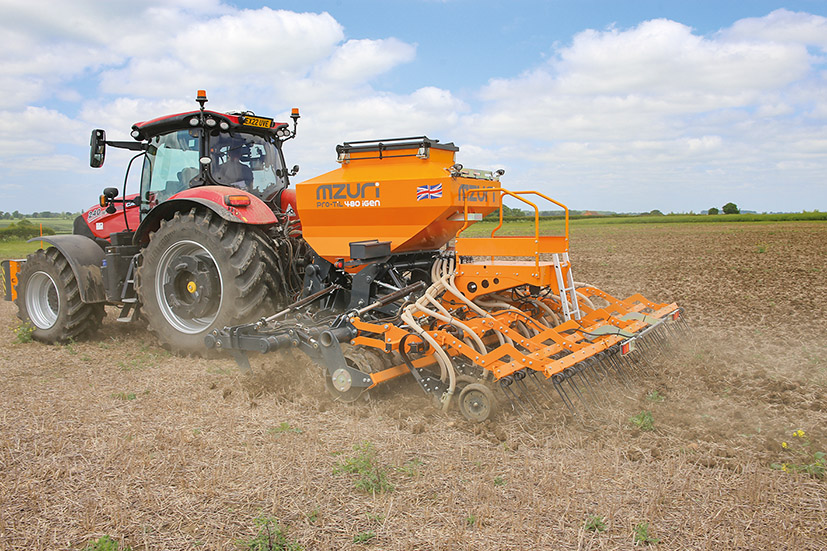
The 4.8m drill is the first mounted model available from Mzuri but incorporates proven design features from trailed drills in the range.
Individual coulters
The new drill has 15 coulters giving 320mm row spacing. Key features from other drills in the range have been incorporated, including leading tines which prepare a nursery seedbed ahead of the coulters, targeted reconsolidation of the seeding zone by a full-width packer roller with a ridge profile to ensure consolidation pressure is applied exactly where it is needed – behind the leading tines, and individually mounted seed coulters for optimum ground contour following and consistent seeding depth.
Each coulter is on a separate spring, attached through a parallelogram linkage to the full-width packer. Press wheels at the rear of each coulter assembly control the seeding depth, and operating pressure is adjusted through the packer roller frame. Pivoting the coulter assembly towards the rear increases pressure on the press and depth control wheel as well as the rear harrow, but a constant seeding depth is maintained. Pressure control is simple – using ram spacers to limit travel.
A double row of z-harrow tines at the rear covers the seed and leaves a level finish.
Accurate at high rates
There is currently no combined seed and fertiliser hopper option as Martin said keeping the operating weight low is a priority, but there is potential to develop a two-section hopper in future for simultaneous seed and fertiliser placement.
The 2,200-litre tank is pressurised and supplies accurately metered seed at up to twice the rate of conventional systems. Twin metering units supply the coulters through a single seed distribution head. The pressurised hopper and twin meters ensure a consistent supply through the 15 coulters even at speeds up to 18kph – which proved successful during trials. “The drill is easy to pull, especially with low-disturbance leading tines and our 240hp tractor had plenty of power and traction. It’s designed to achieve high work rates and at 18kph the finish and results were excellent. If other types of leading tine were fitted then a bigger tractor with more power would be needed to achieve similar speeds, especially when conditions are tougher,” continued Martin.
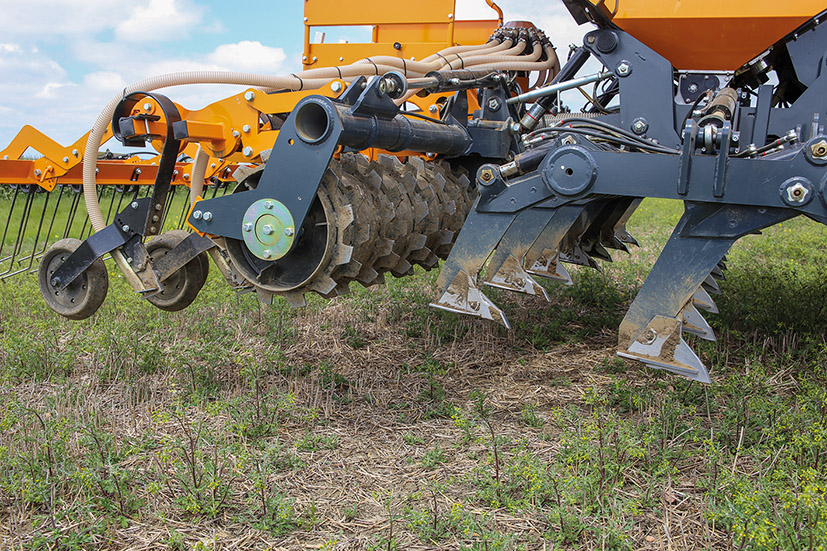
The front leading legs have low-disturbance points and working depth is controlled by the relative position of the tines and the full-width roller.
Superior concept
Martin describes himself as a big believer in the front leg leading tine concept. “They are so much more successful than leading discs in a wide variety of conditions.
“We usually recommend setting the tines to work just 20–30mm below the following seeding coulters to create a tilth at seed depth and allow roots to flourish as crops develop. However, they can work much deeper if extra soil loosening is needed. The drill is strongly made and capable of handling the increased stresses behind high horsepower tracked tractors without any problems,” Martin added.
Early availability limited
Limited numbers of the new drills will be available this autumn, but full production will commence in time for spring drilling next year. Rumours regarding the new drill’s availability have been circulating for some time, and Martin said he has already received many enquiries from potential customers. These include current users of competitor 4.8m drills who have recognised advantages of the Mzuri seeding concept, as well as many already using Mzuri Pro-Til and iPass models.
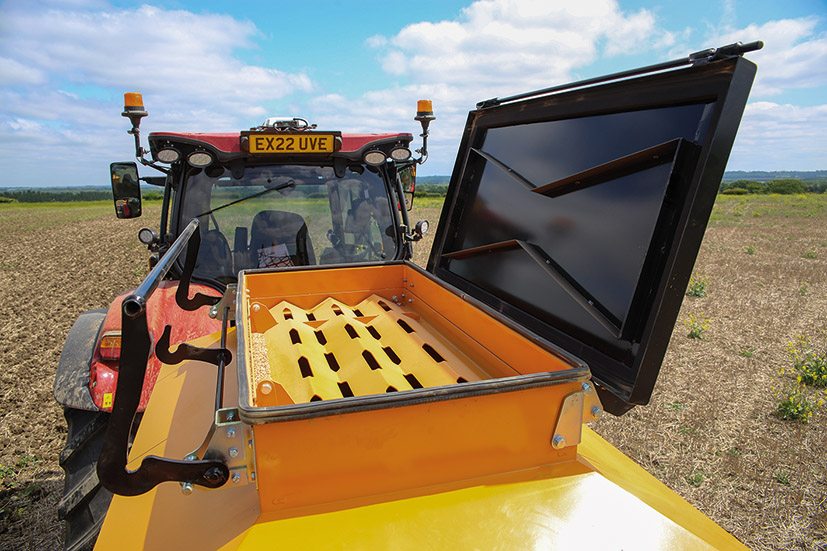
The seed hopper is pressurised. A convenient manual locking system secures the lid.
Strategy works
“Much of our farm is heavy Evesham Lias clay and since adopting a direct-drilling crop establishment regime, our fields have improved and charlock and black-grass populations which were both high when we arrived have declined. Black-grass doesn’t thrive in well-structured soils and the wider row spacing we favour gives a great opportunity for herbicides to achieve maximum efficacy and reduce the small number of plants that remain. We do everything we can to increase organic matter in the soils, and the more chopped straw remains on the surface after harvest, then the more the worms will pull down. We bring in sheep for mob grazing and our organic matter contents continue to increase. Surveys have demonstrated that the amount of nitrate from our field drains is insignificant, and we rarely apply insecticides or fungicides now as the crop health is so good. Our system works well and saves time and costs.
“The new iGen drill will be priced up to 30% less than equivalent trailed machines allowing even more growers to benefit from advantages of our crop establishment system,” Martin concluded.
Demonstrator view
Luke Vallis works on the farm and is also the company’s product demonstrator. “I recently joined Mzuri and had used zero-til and direct-drills on farms previously,” he said. “I am extremely impressed by the iGen. It’s very easy to use and minimal set-up is required. Moving between fields where the soil types vary, most of the time I can just unfold the drill and start working and achieve great results.”
Shop used seed drills for sale on FarmAds.
Excellent dealer back-up and a preference for AGCO products convinced Norfolk-based farm manager, James Brown to invest in its first Fendt Rogator 655 self-propelled sprayer.
South Pickenham Estate near Swaffham, Norfolk, comprises approximately 3,000ha of owned land, most of which is farmed in-hand by farm manager James Brown and his team. Some 600ha is rented out, mainly for carrot, onion and potato production which helps provide an extended rotation. Most of the soils are light, but there are areas of heavier land further north. Irrigation is available for vegetables but can also be used on the farm’s own crops which include winter wheat, winter barley, oilseed rape, sugar beet, winter beans and maize for a local AD plant.
The farm recently invested in its first Fendt Rogator 655 self-propelled sprayer following demonstrations of the Fendt, plus three competitor machines.
“We always shop around, and the price and specification are major factors,” explained James. “We tried the latest version of the sprayer we owned previously, and two others. As we expected, they all had good and bad points, but part of the Rogator’s appeal is that it is a premium product which shares the cab layout and operating logic with our Fendt tractors, so it is home from home for operators moving between tractor operations and spraying.”
Increased work rates
Previous spray systems included a pair of 4,000-litre sprayers, one self-propelled and one trailed, with 32m booms. In 2015, a single 6,000-litre, self-propelled sprayer was purchased and, at the same time, the farm changed to a 36m spray width. The new Rogator 655 also has a 6,000-litre tank and 36m booms but, with superior ride suspension, as well as extremely effective boom suspension and height control, it achieves higher work rates and is expected to complete the annual spraying workload in 1,000–1,200 operating hours per year.
As well as spraying crop treatments, the Rogator also applies fertiliser. “We use liquid fertilisers throughout the year, except for the last dose when we apply granules instead. This helps us avoid risks of flag leaf scorch and reduces pressure on the sprayer when fungicide applications are the priority,” said James.
Improved accuracy and spray efficacy
The farm’s previous sprayer had spray control in three metre sections, but the new Rogator has individual nozzle shut-off and QuadSelect nozzle bodies which each have four nozzles. The optimum nozzle or two-nozzle combination is automatically selected to maintain the ideal droplet size while application rates adjust relative to travel speed. “We immediately saw an improvement because of the individual nozzle control,” said James. “Spraying around obstructions; there used to be triangular chunks where overlaps or misses occurred, but now we have perfect circles and more consistent crops.”
Adjustable wheel track
The Fendt Rogator came with OptiRide hydro-pneumatic suspension which allows the machine height to be raised by up to 45cm, giving 120cm under machine clearance for working in tall crops including maize and oilseed rape. It was also specified with OptiTrack hydraulic-adjustable track width which allows the wheel spacing to be altered between 1.80–2.25m from the cab. James explained that an alternative option would have been to change the track width used in the farm’s cereal crops to match the sugar beet and maize, and save money by purchasing the sprayer with standard fixed axles. However, he believes that the convenient adjustment gives the farm additional options for the future and will also allow the Rogator’s use for applications to vegetable crops grown by the farm’s tenants, if needed.
There are two sets of wheels for the sprayer. Wider flotation tyres are used on stubbles and during the early growth stages. Later – narrow wheels are fitted to reduce crop damage. The Rogator’s wheels are 2.05m diameter, and this means that even on the narrow row crops there is still a large footprint, and the sprayer travels well on soft, wet ground.
AGCO telemetry
Like the farm’s AGCO tractors, the Fendt Rogator sprayer has telemetry as standard. “Using the AGCO Connect smartphone app: we can view the locations and work status of all the tractors and the sprayer in real-time,” commented James. “It’s a definite advantage of operating machines which are all from the AGCO family. The app is a useful management tool and being able to monitor task progress remotely helps us plan our activities.
“The TNS workshop team uses it too. The diagnostics function allows technicians to check remotely for errors and, if a visit to the farm is needed, then the engineers can check the machine’s location. AGCO Connect is reassuring when it comes to operator safety; particularly if people are working alone. If we can’t contact an operator, we can check whether the machine is still working, or see if it has returned to the yard.”
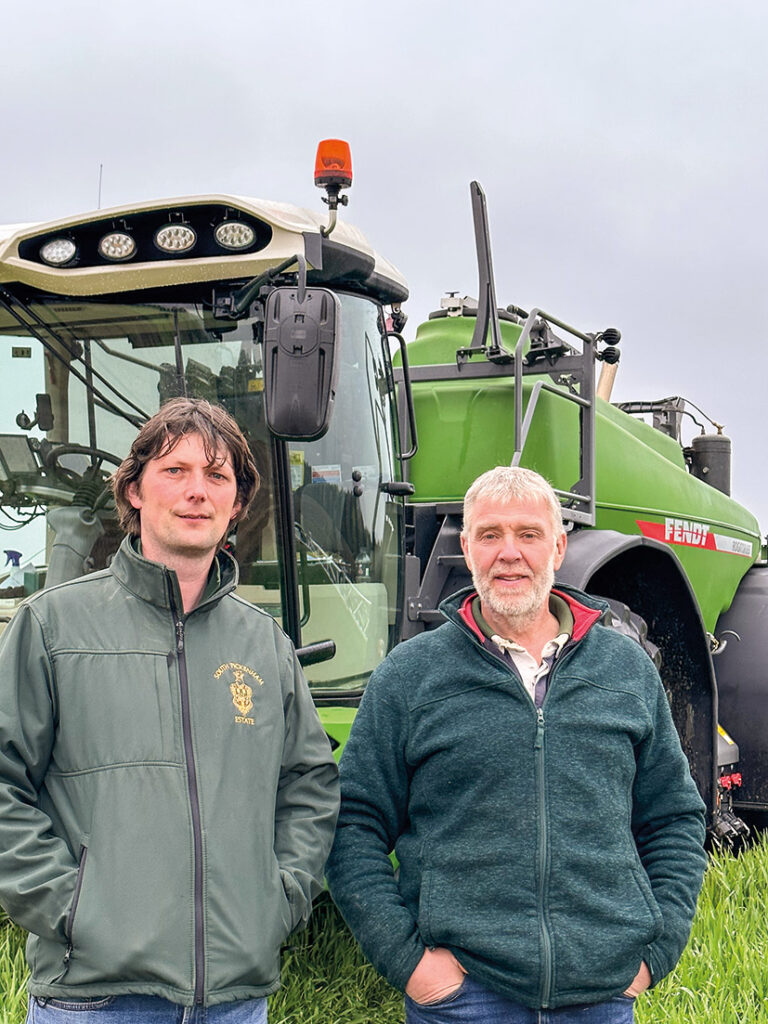
South Pickenham Estate farm manager, James Brown with sprayer operator, David Dye.
Best cab on the market
David Dye is the sprayer’s main operator. “I believe the Rogator’s VisionCab is the best on the market, but it’s a Fendt so that is expected,” he said. “The ride quality and comfort are very good. Even with a full load, the engine runs at only 1,200rpm so it’s particularly quiet. It’s a pleasant place to spend the day.”
David describes the tank filling system as excellent, and he likes the large 60-litre induction hopper which handles two bags of powder at a time with ease. “I usually set the automatic tank filling system to stop early, giving me time to add the chemicals before topping up with water,” he explained. “The pause function is handy for filling fertiliser too. We use a 3in hose, and the 785 litres/min pump fills the tank in just over five minutes.”
The automatic boom height control system is reliable although it can be over-sensitive to crop density which means it drops in areas of thinner crop. “It is very reactive, but even where crops are uneven, the automatic mode works well,” he stressed.
Work rates
Average work rates are approximately 180–210ha per day. “It achieves that very easily, even though many of our fields are quite small,” David continued. “It’s got everything I need to do a good job and allows me to take pride in the results.”
Dealer back-up key to buying decision
The farm’s current tractor fleet includes five AGCO brand tractors, three of which are Fendts. They were all supplied and are looked after by the TNS team. “The tractors perform well, operators like them and they are reliable,” James stressed, “but we still wouldn’t consider them without effective back-up. Area sales manager, Jolly Bullen is based at the Attleborough depot. He’s our main sales contact and always friendly and helpful. He’s familiar with our business and knows what we need. The workshop team at Attleborough have looked after our AGCO tractors for many years and are excellent. The sprayer specialists, Gareth Bell and Ben Miller are based further away at the Littleport depot, but when help is needed they are always available by phone and use their experience as well as remote access to the sprayer’s telemetry to resolve issues quickly. The Rogator has been almost totally reliable since it arrived in January, but we know that even if something major goes wrong, we won’t be without the machine for long.”
Fast charging
The machine boasts the largest standard battery pack in its class, with 20kWh capacity, JCB says.
The 403E has a built-in charger that allows connection to a range of on-site power sources. A 110V socket will fully charge batteries in 12 hours, while a 230V industrial or domestic plug will charge in eight hours. JCB’s off-board rapid charger delivers a full charge from a three-phase supply in just two hours.
Electric motors with three driving modes
The machine is equipped with two independent electric motors, one for the driveline and one for the hydraulics. The drive motor offers 33.4kW of power and comes with three driving modes, that the operator can toggle between using two buttons on top of the joystick.
Drive is transmitted through an integrated drop-box to ZF axles that can be supplied with open differentials or with differential locks for maximum traction. The loader is offered with a choice of narrow or wide wheels, plus the option of agricultural or industrial tyres.
Standard or high-lift arm configurations
The loader arms are available in standard and high-lift configurations. The standard lift arms deliver a pin height of 2.9m, while the high-lift model achieves a 3.1m pin height. Both loader arm set-ups come with a hydraulic quick hitch as standard and the loader arms provide true parallel lift.
Tipping load provides versatility
The 403E offers a tipping load of 972kg with pallet forks, within a transport weight of just 2,671kg. This makes it an ideal machine for use on farms with more than one set of buildings, as well as for contracting, landscaping, fencing and other related activities, according to JCB. A heavy-duty counterweight is available as an option, increasing the tipping load by 118kg and the transport weight by 121kg.
Dynamic response and precision control
The machine has a 20kW high efficiency hydraulic pump motor and the hydraulic system offers two operating modes, controlled by a rocker switch on the main console. Shovel/bucket mode provides dynamic response, while the fork mode delivers increased precision control. A programmable constant flow auxiliary feature is also standard, to power motorised attachments such as bedding spreaders used in cubicle houses or open yards, hay and silage bale processors, and yard sweepers, with the operator setting the flow rate through the main display and rotary controller.
An impressive machine
The 403E is offered with a fixed or folding canopy initially, with a fully glazed cab as an alternative from Q3 in 2023.
The machine has a single joystick with a proportional auxiliary controller on top. An optional second auxiliary roller can be provided, allowing the operator to access all loader functions from one lever.
There is a new multifunction digital display, controlled by the rotary controller to the right of the loader joystick. The operator can use the rotary controller to set auxiliary hydraulic flow rates, inching travel speeds and other settings within the display. The monitor also provides all critical machine operating data, including driving mode, state of battery charge and travel speed.
Shop used loaders and other materials handlers for sale on FarmAds.
Case IH has extended its Optum range with a new 340hp model that promises enhanced performance, durability and reliability, as well as a new cab and telematics and connect packages.
Despite multiple improvements, Case IH says the Optum 340 CVXDrive with AFS ConnectTM is no heavier than the existing 300 and 270 models, but provides more power, ultimate productivity, and the ability to handle any task. It caters for the growing market for multi-purpose, high power tractors, maximising the Optum concept of high power, low weight tractors that can be ballasted as required.
It’s ideal for draft and PTO applications, from tillage and seeding to mowing and transport, the manufacturer reckons, and it has one of the quietest cabs on the market.
Features include:
- 6-cyl, 6.7-litre stage 5 FPT engine
- Hi-eSCR2 emissions reduction technology
- Automatic Productivity Management
- An upgraded CVXDrive transmission which incorporates improvements to the hydrostatic unit and control software, driveline components, rear differential, and rear PTO
- A new external engine blow-by filter to reduce service time
- 630-litre fuel tank and 750-hour engine service schedule.
New high power range
To increase versatility and compatibility in daily operations, the standard Isobus Class 3 can be upgraded to Tractor Implement Management (TIM), the latest tractor-implement communications protocol, so that certified implements can automatically control specific tractor functions.
The new model offers 27hp, or 9%, more power than the Optum 300 CVXDrive, while peak torque is 1,398Nm at 1,400rpm, compared with 1,282Nm at the same speed for its smaller stablemate.
The powerful rear linkage which can lift 11,058kg, a front linkage with a maximum capacity of 6,016kg, and two-speed front and four-speed rear PTOs further enhance the tractor’s versatility.
More room, more functionality
Features of the new spacious cab include excellent all-round visibility and a key fob for keyless operation, Case IH says. The redesigned ergonomic Multicontroller armrest puts 95% of the most-used functions at the driver’s fingertips, many of which can be operated either via the touchscreen or new integrated turn-and-press encoder dial. For ultimate operating and ride comfort, an optional new semi active cab suspension can be chosen.
Advanced technologies
The new AFS Pro 1200 touchscreen monitor with Bluetooth functionality gives an overview of all tractor functions. It helps the operator optimise engine, transmission, hydraulic and PTO performance, while also managing the operation of the implements. The new AFS Vision Pro operating system enables precision farming functionality, tractor systems and connectivity to match the required operating preferences.
An array of advanced technologies available only from Case IH are also included, such as a five-year subscription to the AFS Connect advanced telematics portal which enables remote monitoring and management of farm, fleet, and data. It also comes with Safeguard Connect, a comprehensive package of value-added services, and a three-year subscription to Case IH MaxService, which operates around the clock during peak season in partnership with the dealer network to maximise machine uptime. Finally, pre-season checks, pro-active support and training is provided.
Take a look at the second-hand tractors for sale at FarmAds.
Kuhn’s new high-capacity trailed sprayer
The Lexis is compact and lightweight despite its ability to carry 4,000 litres. It has a maximum length of 6.9m and an overall width of 2.55m. Featuring aluminium booms up to 28m, the Lexis still has an unladen weight of just over 3 tonnes. The latest model also features new 1.85m tyres with a very high flexion (VF) option from 320–520mm which will help to reduce compaction and protect soil health.
The Lexis can be specified with Kuhn’s Manuset manual rinse operation which only requires two main valves that are controlled from the operator’s control station. Multifunction handwheels reduce handling operations by up to 50% and the ergonomic design means valves are easily operated for a simple, trouble-free set-up.
During rinsing, a complete turn with the delivery circuit handwheel ensures that the water drawn in by the pump is conveyed into all sprayer circuits. The rinsing tank level gauge, visible from the workstation, also enables easy sequencing of the rinsing operations.
The new Lexis is also available with Diluset+ which offers operators assisted management of filling and dilution of residual volumes.
Spraying with the Lexis can be operated using Kuhn’s Canbus control box, a CCI 800 or 1200, or
any other Isobus terminal.
The Lexis is stable and manoeuvrable because the shape of its tank has lowered the centre of gravity. This improves stability, even with a reduced track width of 1.5m or when spraying on gradients. The short tow eye-axle distance of 4.30m coupled with the Track Assist gyroscopic steering drawbar system also improves tracking in the tractor wheels.
The Lexis can be fitted with CCE individual nozzle control, Autospray PWM technology or the Boom Assist Extreme contour control system. Kuhn’s CCI Connect solutions and MyKUHN portal also provide remote access to the machine and feedback on the tasks performed to harness valuable operational and application data.
A new option for farmers and contractors needing a high output direct tine drill is available from Virkar. Farmers Guide’s David Williams visited Samagri Ltd, the manufacturer’s UK importer, to see it at work.
Virkar direct drills have been manufactured in Spain since 2010 and are imported to the UK by Hampshire-based Samagri, which took on the brand in 2018 to complement its existing Kockerling machinery range. “The Kockerling line-up doesn’t include dedicated direct drills, so adding Virkar has allowed us to provide a solution for the growing number of farmers looking for drills capable of establishing crops into both cultivated and undisturbed soils,” explained Samagri sales manager, Nigel Long.
Coulter options
Virkar’s drill range includes Dynamic models in working widths from 4.5–7.0m, and larger Ocean models which are available with working widths up to 8.0m currently, but from September this year there will be versions up to 15.0m wide. This is the first time that tine-only coulters have been available from Virkar, and the new option can be specified for all drills right up to the widest 15.0m.
“Of the drills sold in the UK since we took on the brand three years ago, 24 have been Dynamic DC (disc and coulter) models – with a leading disc to cut through trash and create a slot ahead of the seeding tine which is followed by two closing press wheels,” explained Nigel. “There has also been demand for the Dynamic D (disc) version with a simple single disc coulter, and we also offer a (DD) double-disc coulter version which features a Turbo disc in front of the disc coulter to cut through residues and prevent hair-pinning.”
All models have up to 35cm of vertical coulter travel, with even seeding depth across the width ensured by a pressure accumulator. The coulters bolt directly to the main frame, rather than relying on separate brackets and Nigel explained that this ensures maximum strength and performance. The complete central section of the drill including the chassis, hopper and frame are identical whatever type of coulter is specified, so it is possible to change the coulter type during the season, or as the transition to zero-tillage progresses.
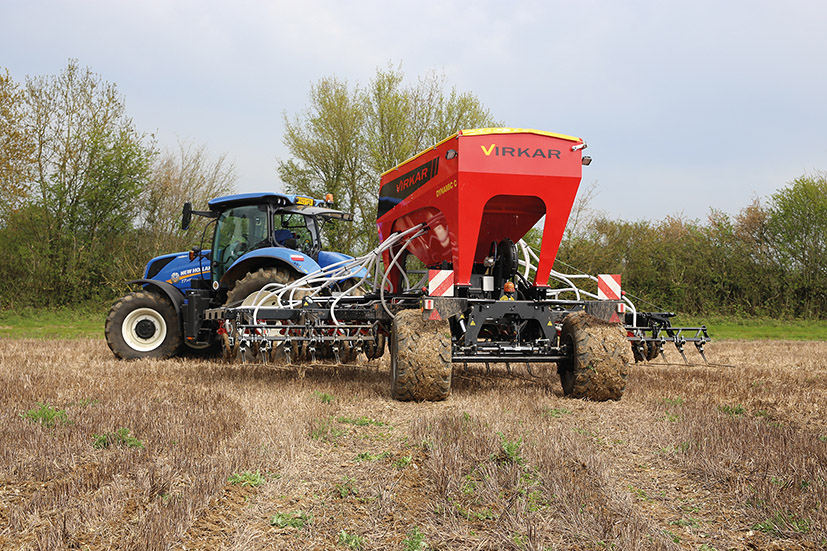
The rear steering axle helps maintain constant seed row spacing during turns and on cross slopes. It also allows the 6m drill to make consecutive passes with headlands of only 12m.
Affordable and versatile
“Although the DC leading disc and tine coulters have been most popular so far, buying the drill with the new tine-only option provides considerable cost savings. For those not drilling into high trash volumes or cover crops, then the simpler tine-only design is a cost-effective solution,” he continued. “It offers the same precise depth control which for many growers is a priority, and the coulters are staggered for the widest possible spacing to ensure trash and large stones flow through easily without creating blockages.”
Easy conversion
The coulters are divided between four rows, and 19 or 25cm row spacing is available – even on the widest versions. The modular construction allows the working width to be easily altered by bolting on or removing sections. The main frame is pre-drilled which makes it possible to convert the drills from 19 to 25cm spacing to suit different crops during the season. In addition, alternate rows can be shut off to achieve double row spacing.
Coulter pressures up to 280kg ensure reliable ground penetration and depth control. Pressure is adjusted from the cab, and Samagri director Sam Berry said that this allows users to optimise the drill’s performance and ensure consistent seeding depth as soil types and conditions vary between fields, or within the same field. Control is through an Isobus link, and possible future developments include the ability to automatically adjust the pressure according to field maps and the GPS location, reducing the operator’s workload.
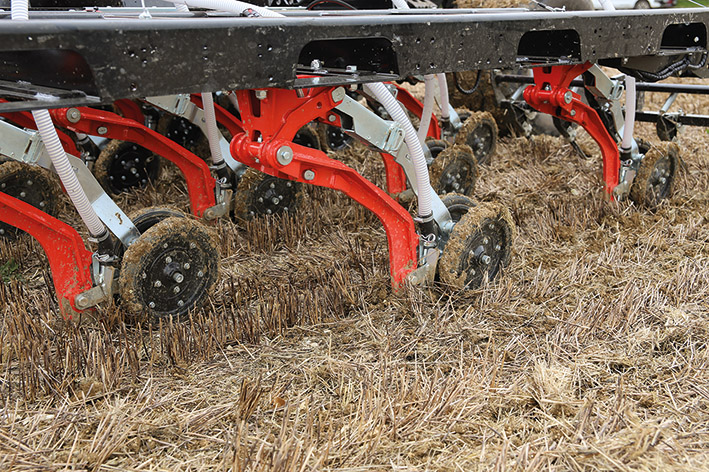
A pair of wheels with a slight stagger follow the tine coulter and close the slot, ensuring seed to soil contact.
Improved accuracy and manoeuvrability
Large rear transport wheels have active steering, controlled by a potentiometer on the drawbar. The steering compensates during turns to keep the seed rows at the correct spacing, and it can also be controlled by the operator to compensate for slip when working on cross-slopes. Control by GPS is an option. “The steering angle is very small, but it makes a surprising difference to the drill’s performance,” suggested Nigel. “It also allows return working bouts, even on small headlands.”
The 5,000-litre drill hopper can be divided into three sections, split longways to maintain even weight distribution. Three Accord-type metering units are used on the Dynamic drills. The flow from all three units is combined and delivered through a single tube to each coulter, avoiding the need for wider working elements which would move more soil. Virkar’s own metering system is fitted to Ocean versions, which have larger 10,000-litre capacity hoppers capable of being divided into four sections.
There are four rows of coulters with 19mm or 25mm row spacing. The coulters have up to 35cm vertical travel. The working pressure across all the coulters is linked through a single circuit with an accumulator, allowing convenient adjustment from the cab.
Tine advantage
“We are very pleased to have the new tine coulter drill which will allow us to provide solutions for even more farmers and contractors,” said Sam. “On hard, clay soils and stony ground, then tine drills perform better than disc drills, and the tines will perform better in wet, sticky conditions too. Also, being less expensive than a disc, or disc and tine drill, it’s a more affordable option for those just starting the transition to direct drilling.”
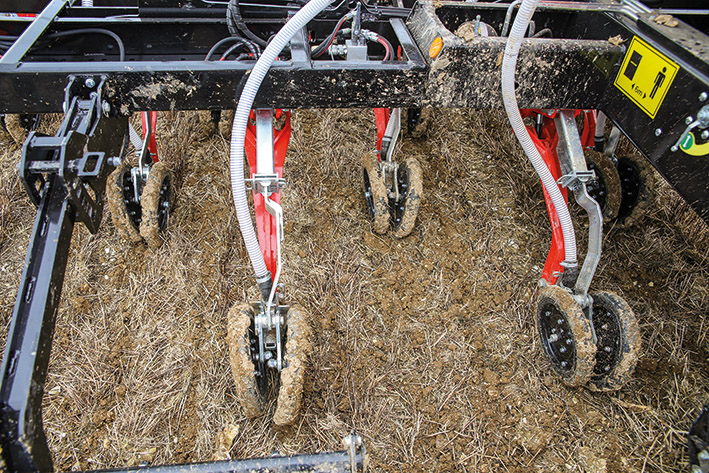
The staggered, open tine arrangement is popular with operators as it is easy to monitor all the coulters from the cab, and very resistant to blocking.
Saving costs, improving soils
“It’s been noticeable that more farmers are considering the move to direct-drilling regimes for a host of reasons; from reducing establishment costs and saving time, to improving soil health. Many have managed a gradual transition from full inversion tillage to min-till regimes and then direct-drilling, and others just moved straight to direct-drilling.
“Some of our own farm is direct-drilled and the rest was pre-cultivated, but this spring’s weather highlighted that on our Hampshire flint and clay soils, the direct-drilled land recovers much more quickly after wet weather, which increases opportunities to get on the fields to apply fertilisers and crop treatments in a timely manner.”
Attractive features
In Spain, Virkar drills are the most popular choice for direct-drilling, and the UK has become the brand’s number one export market. Nigel isn’t surprised. “It’s a rugged and well-designed drill, with attractive features,” he stressed. “The amount of coulter travel is exceptional and whether ground undulations are across or along the drill, they can adapt to maintain consistent seeding depth. Achieving even establishment is key to effective crop management throughout the season, and when potential customers see the drills working the benefits of the design are immediately obvious.
“The coulters are rugged and create very little soil disturbance. The amount of stagger between the four rows allows plenty of space for trash, and if the crop establishment system evolves or changes then the coulter type can be easily changed. The drill can also accommodate a rear three-point linkage, allowing implements such as spreaders, harrows or a roller to be attached.”
Sam commented that several farms near the Samagri Hampshire base have invested in Virkar drills recently. “I think that because we farm on soils that can be quite challenging, customers from all over the UK can tell that we understand their farming challenges and trust us to recommend appropriate solutions. We use both a Kockerling drill and a Virkar on our own farm and both systems work well. It has been interesting that since we took on the Virkar range, many growers in the local area have seen our crops, looked at the drills and then invested.”
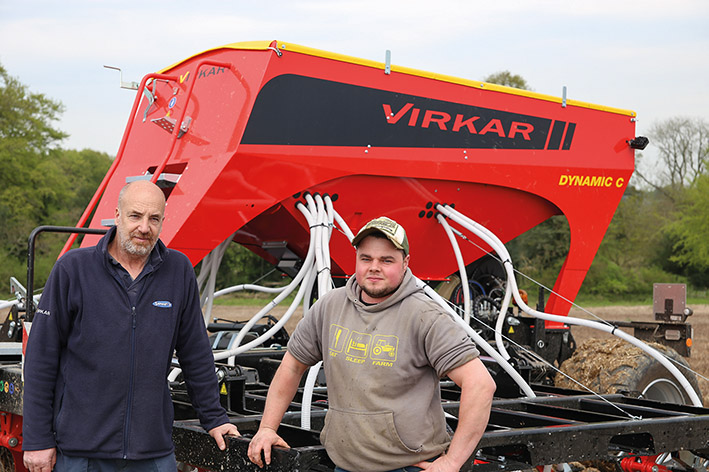
Sam Berry (right) with Nigel Long.
Attractive pricing
The new Dynamic C tine drill is available now to order, and the larger Ocean C version will be available from September. Prices for a Virkar Dynamic C 6m drill with 25cm coulter spacings start from approximately £90K, the DC leading disc and tine coulter version costs from £110K and the D disc, and DD double-disc models are from approximately £120K.
Browse second-hand drills for sale at FarmAds.

